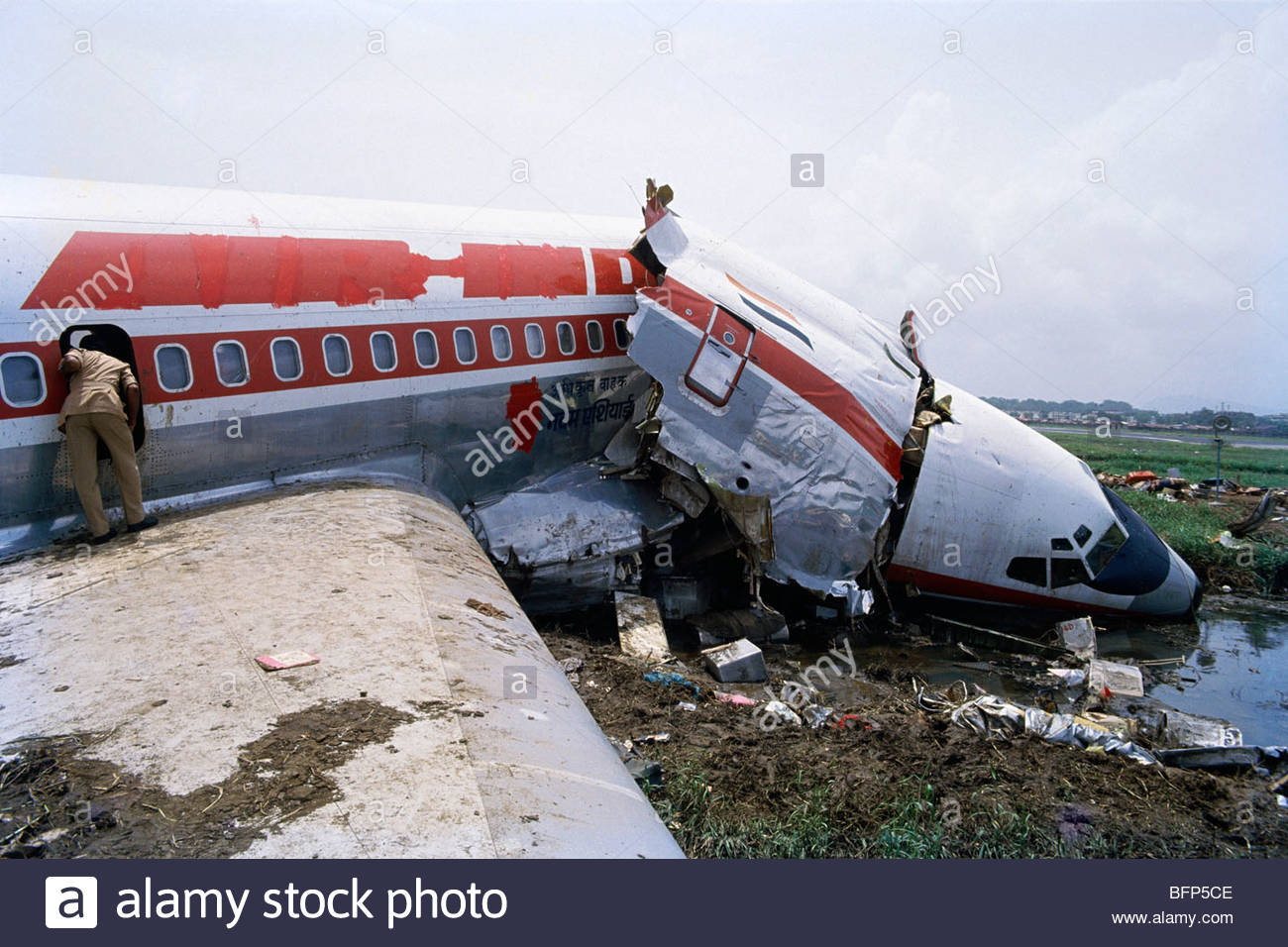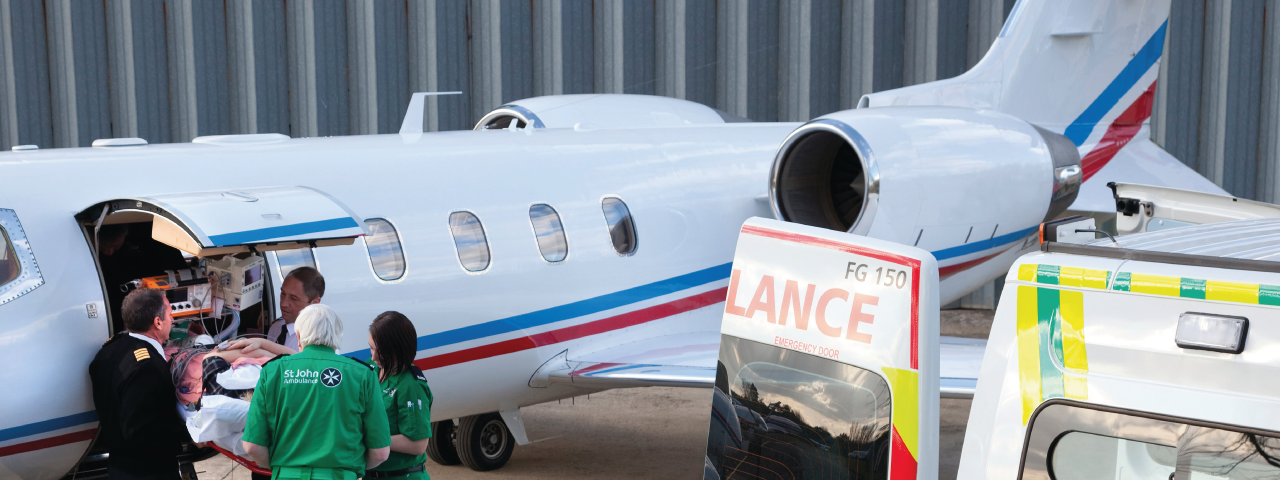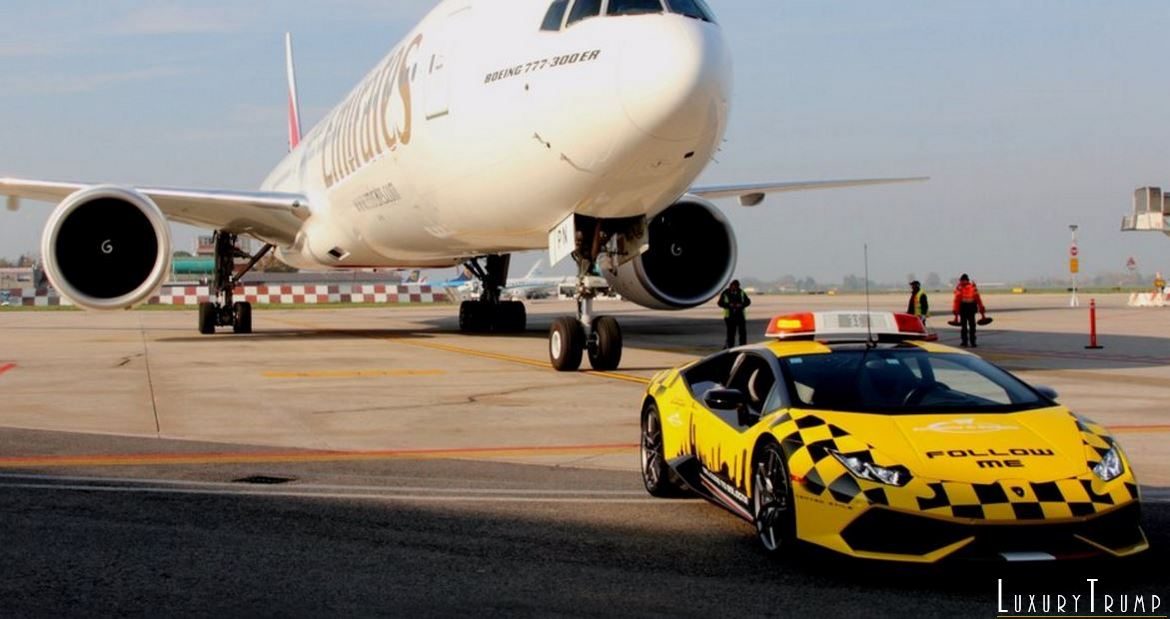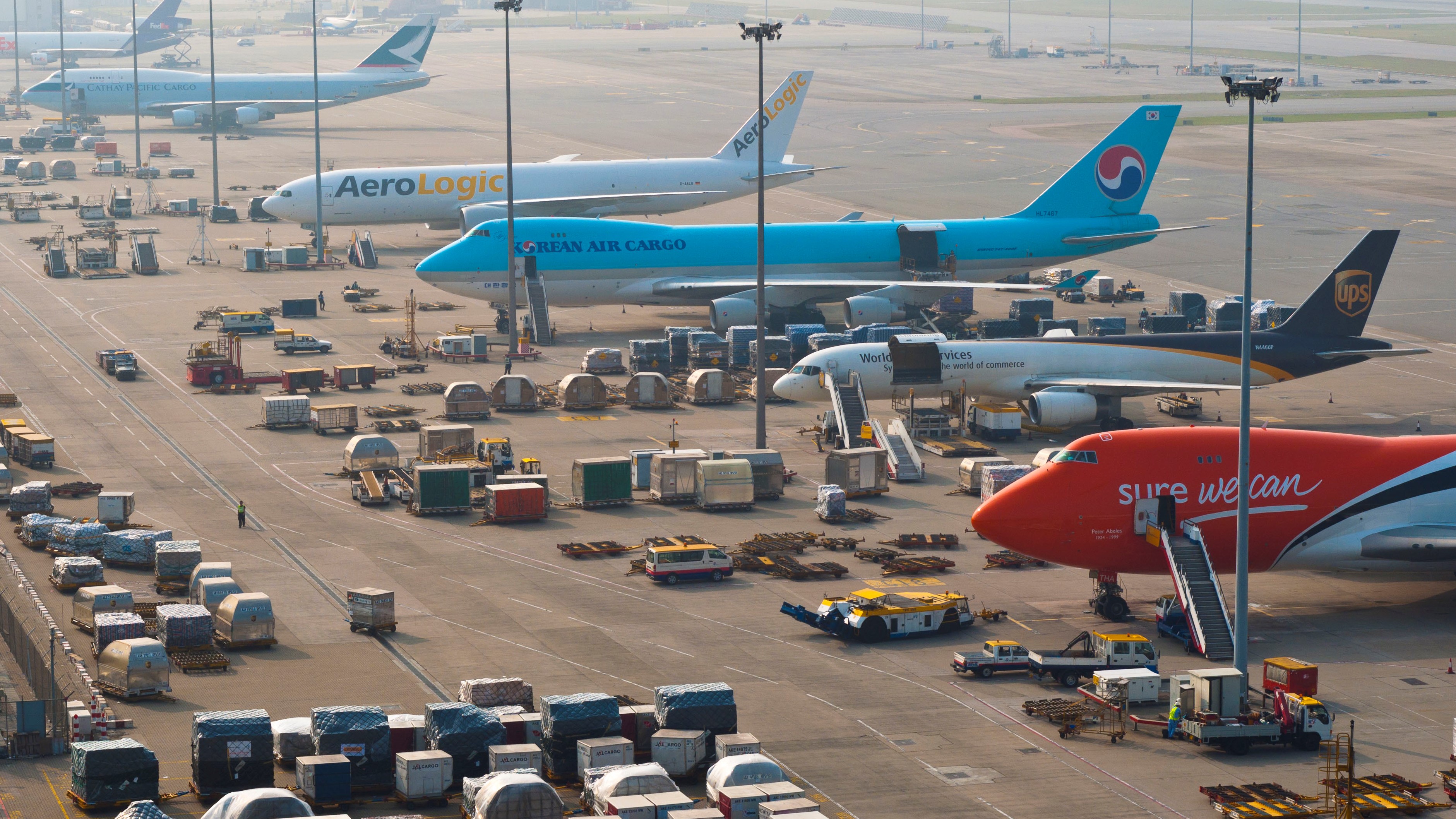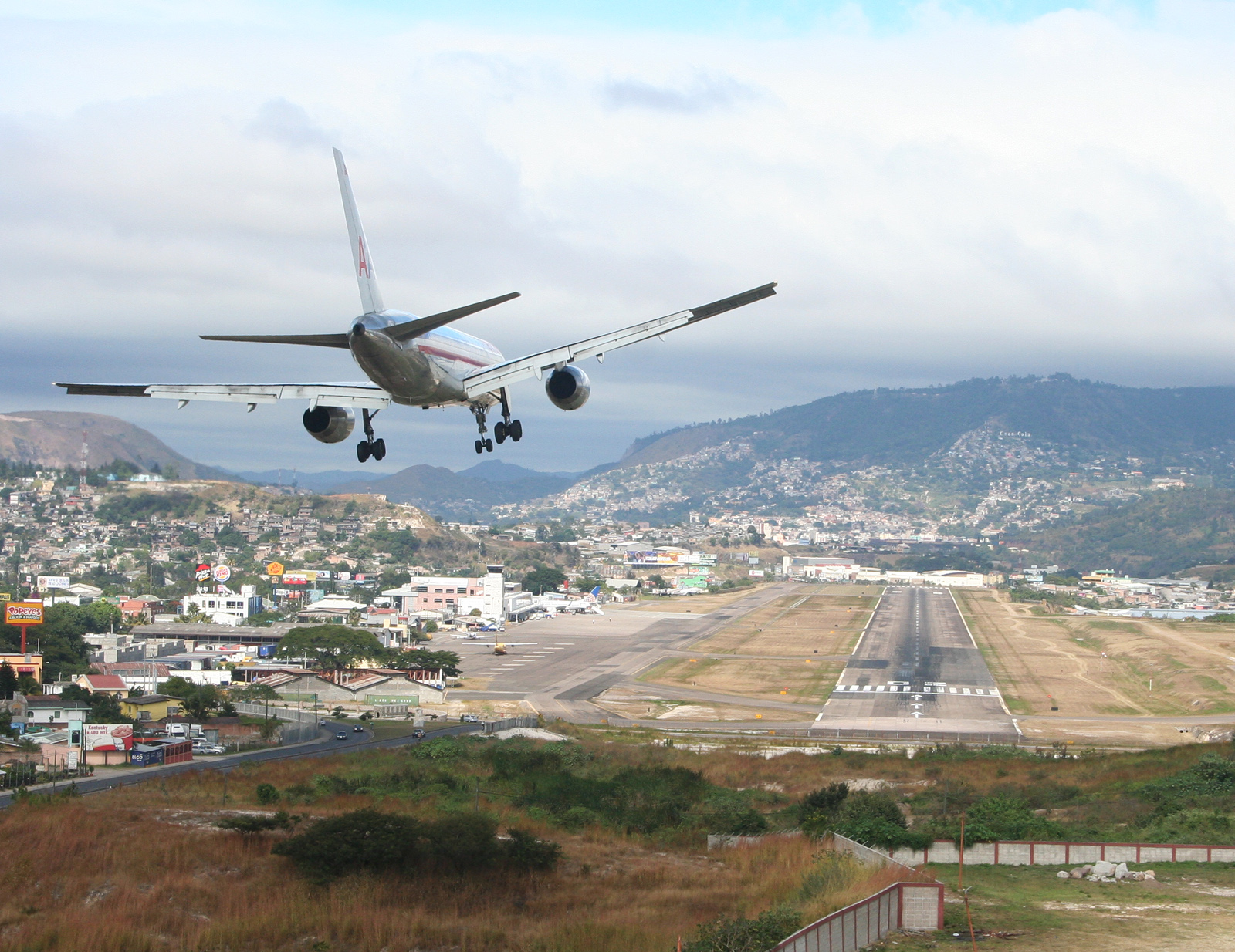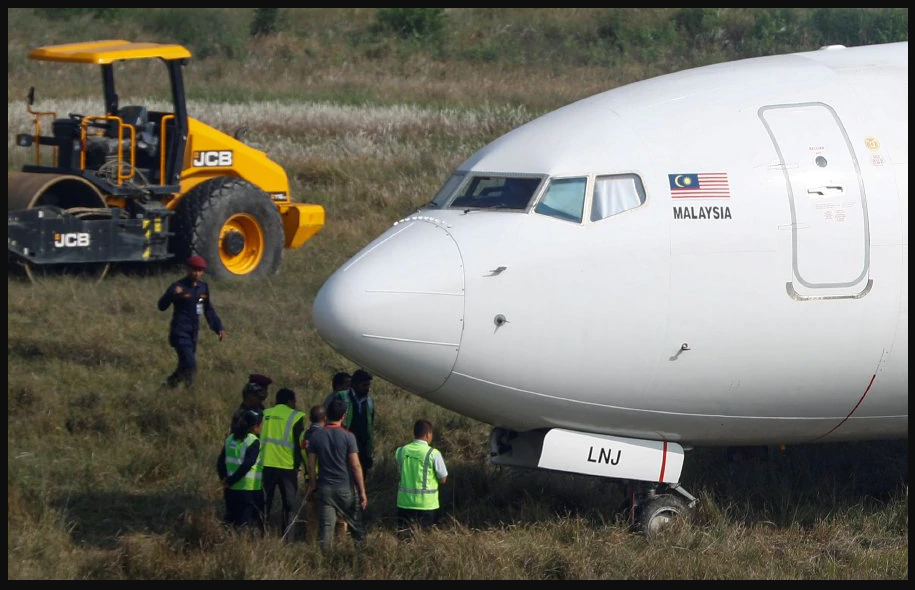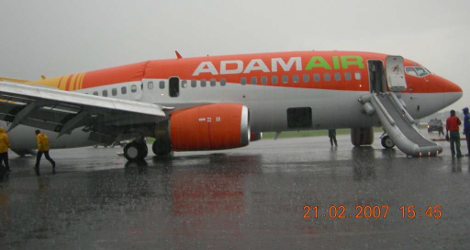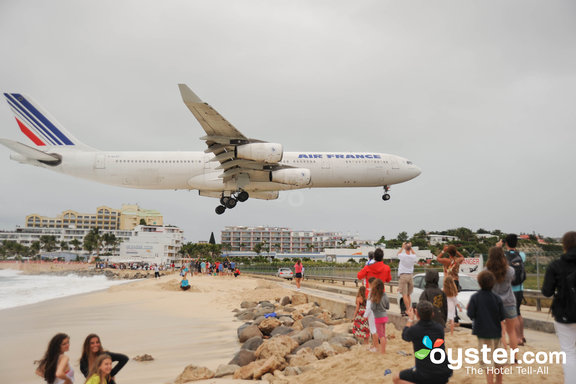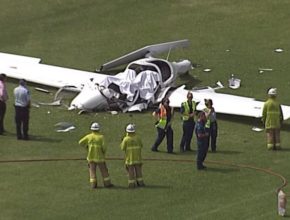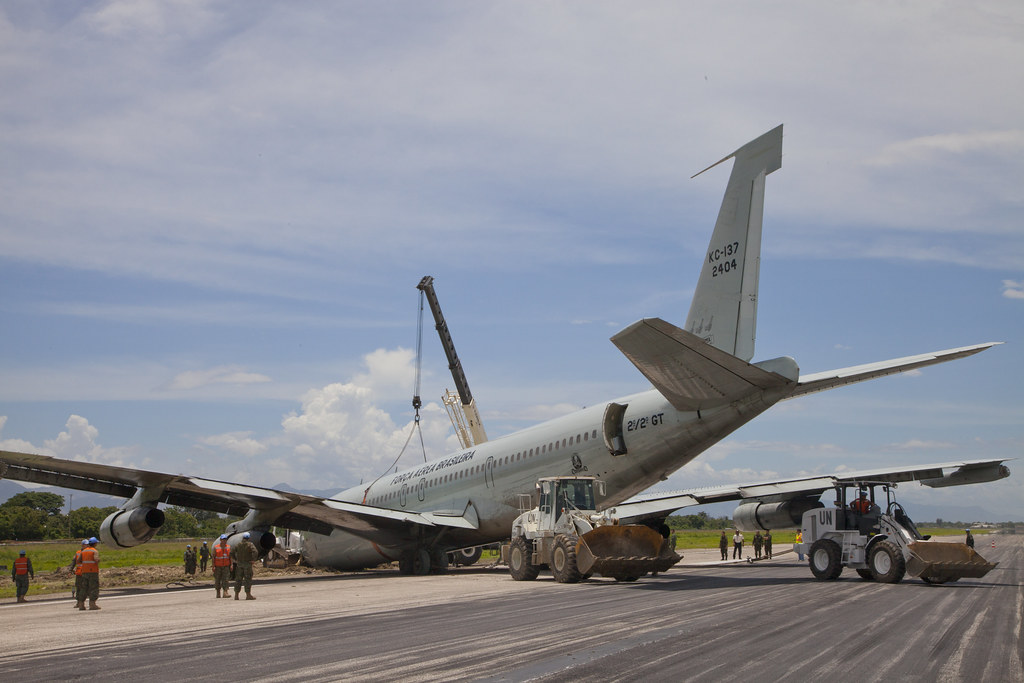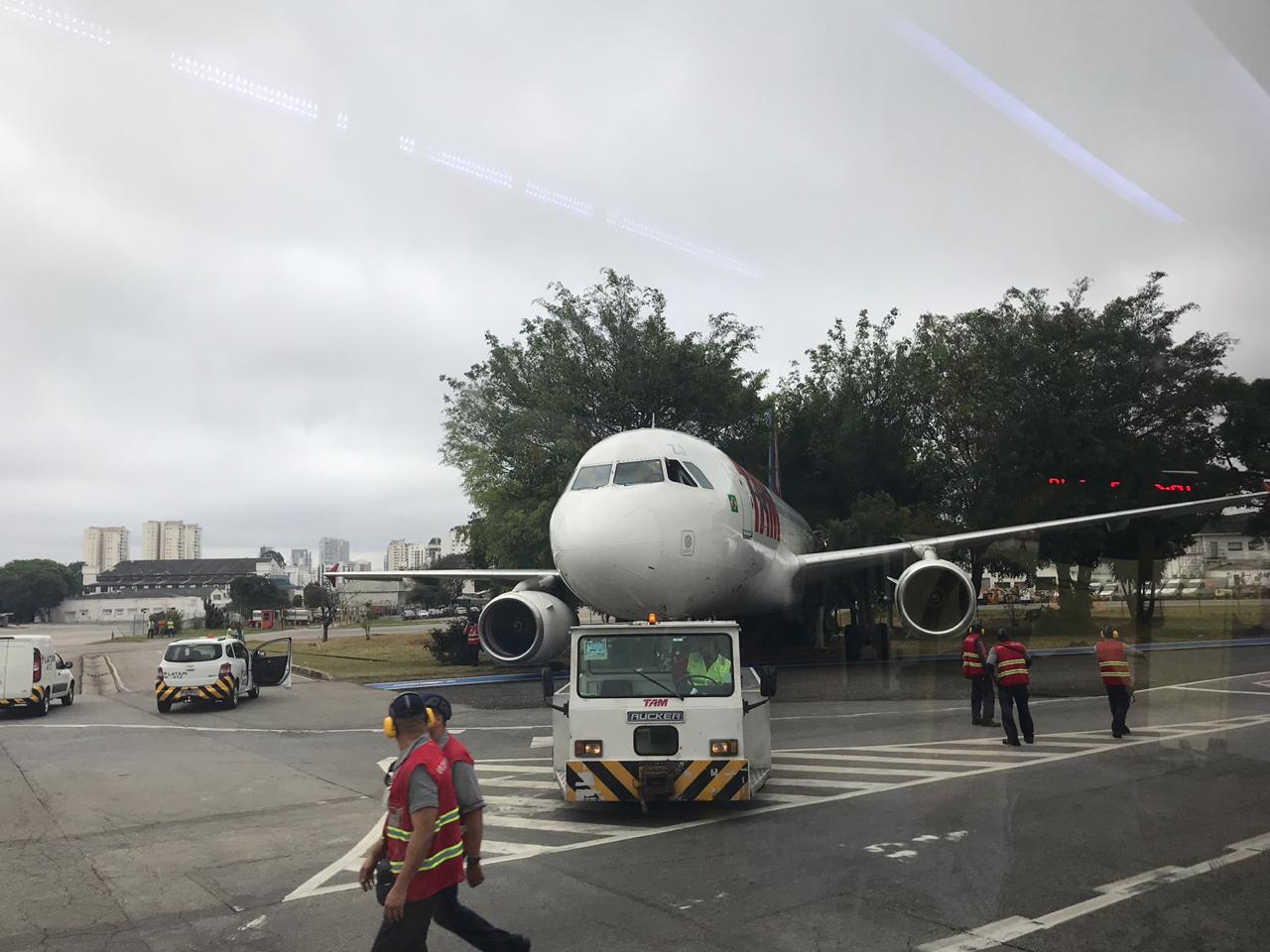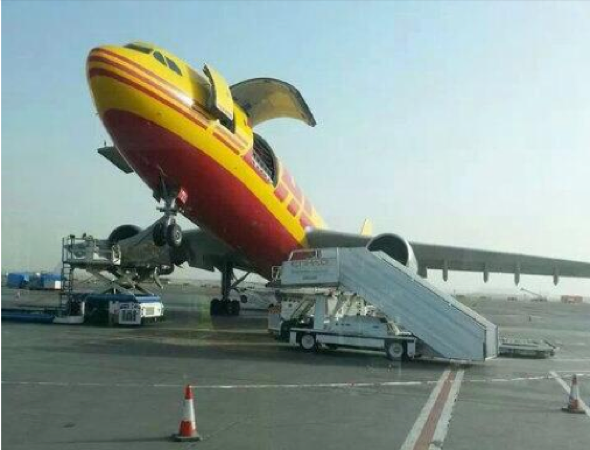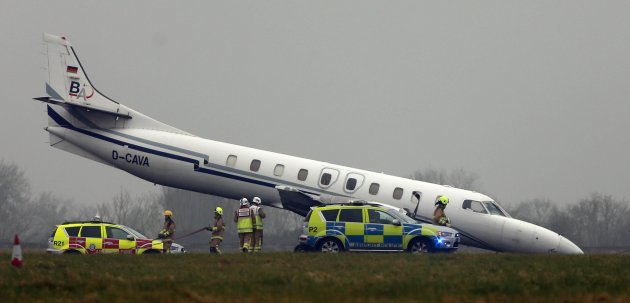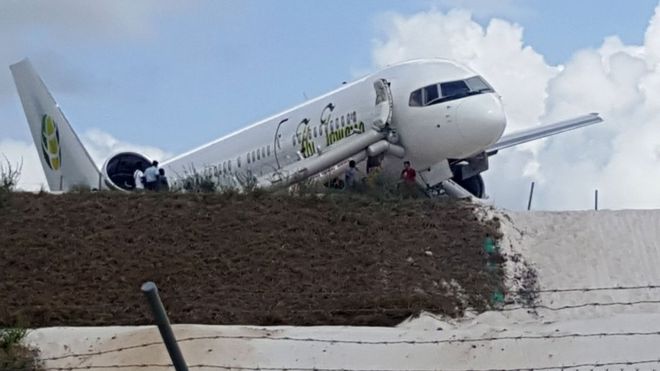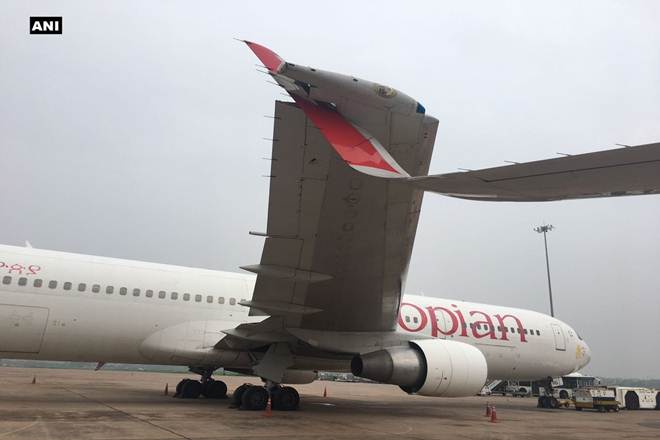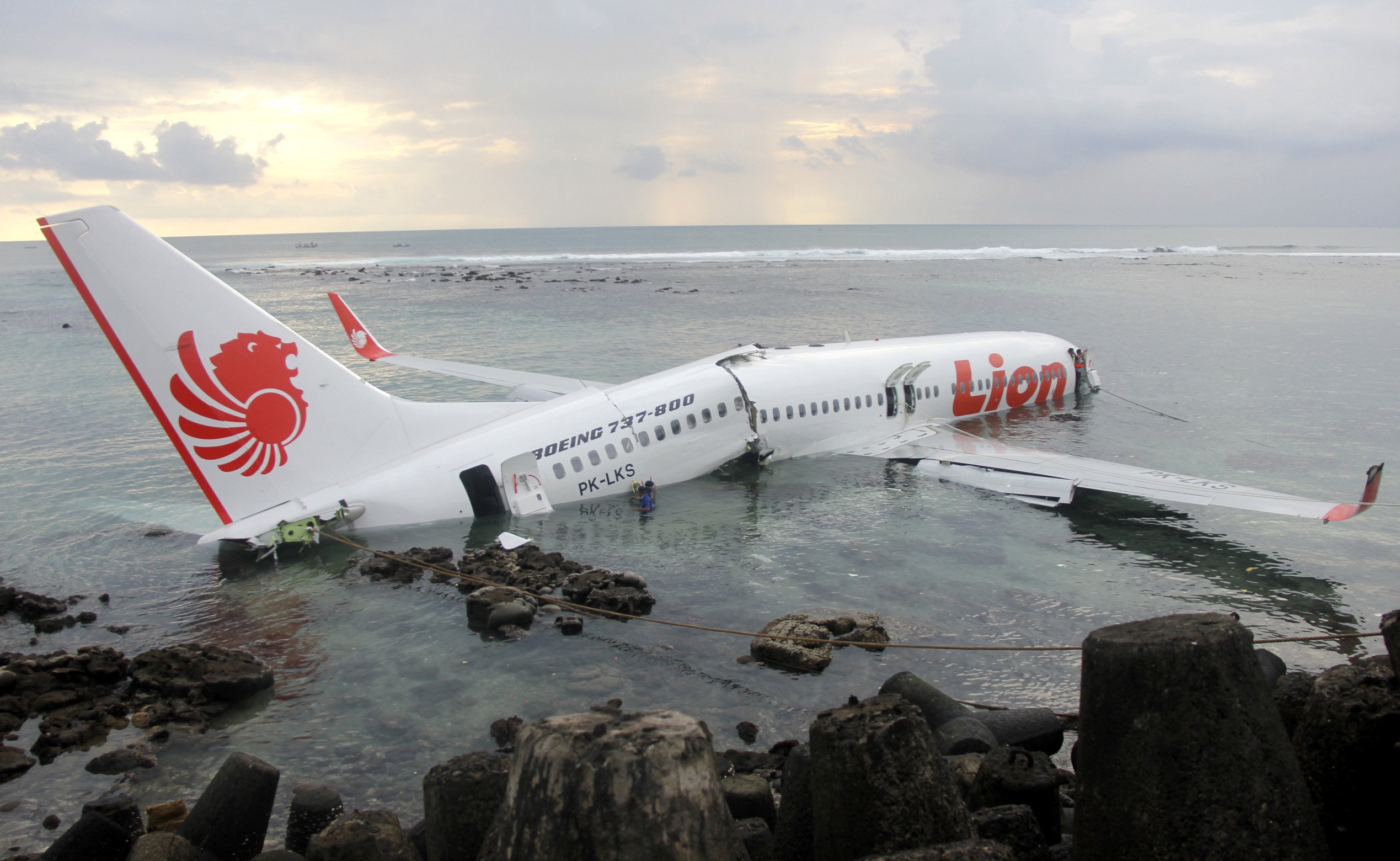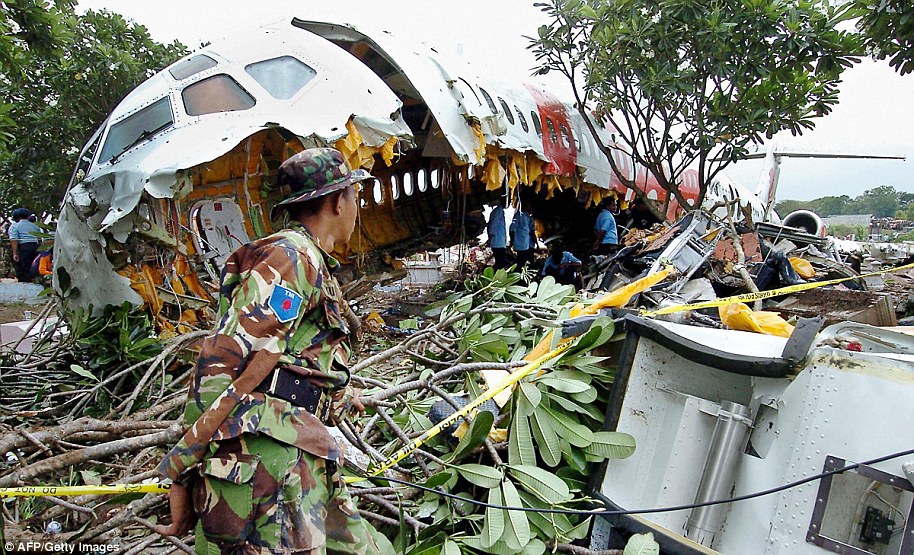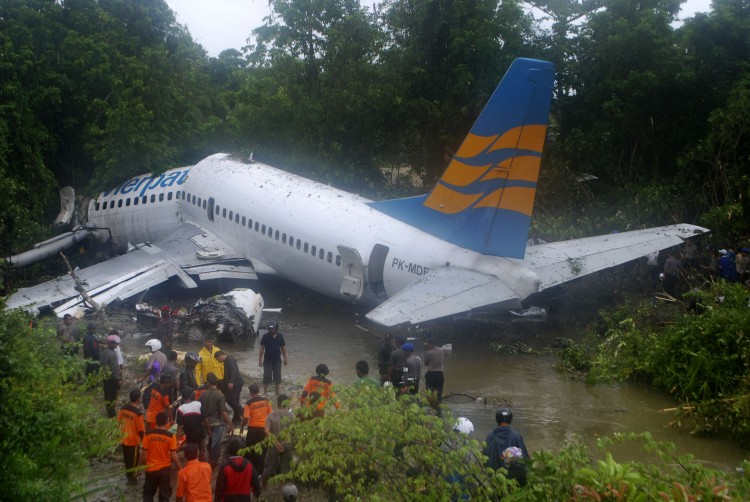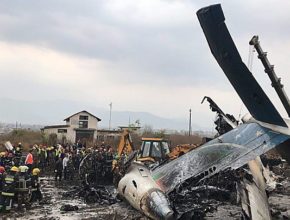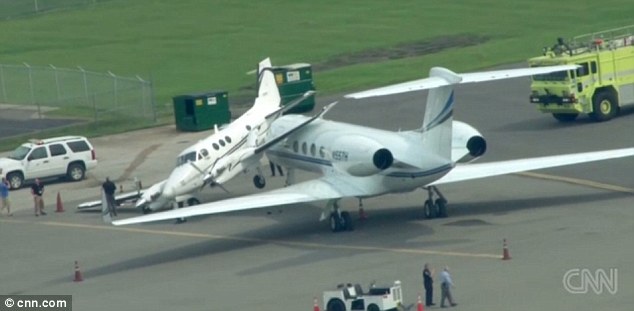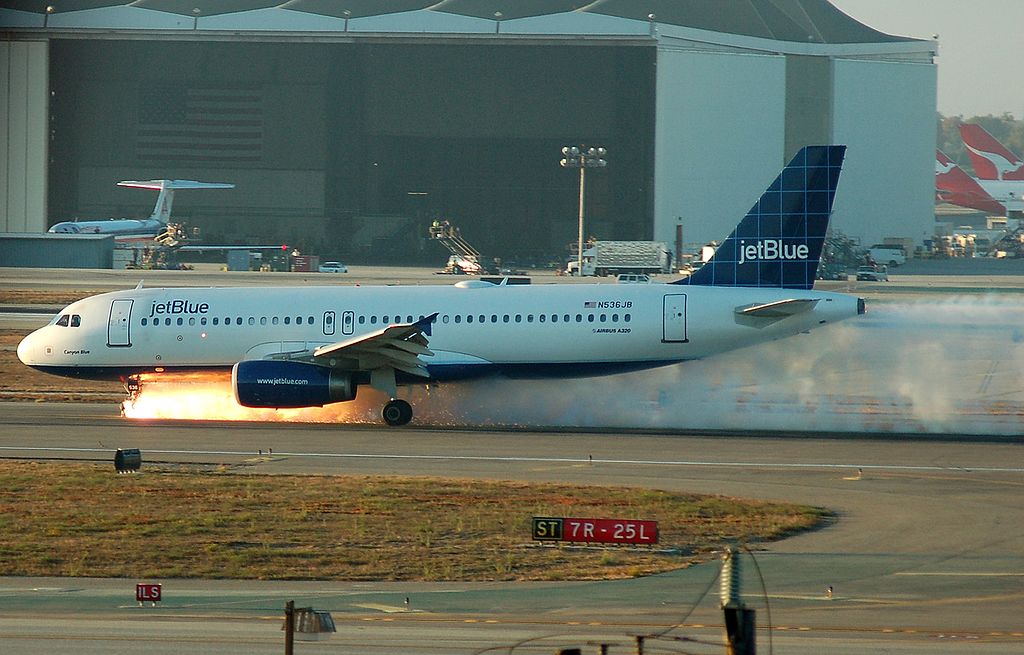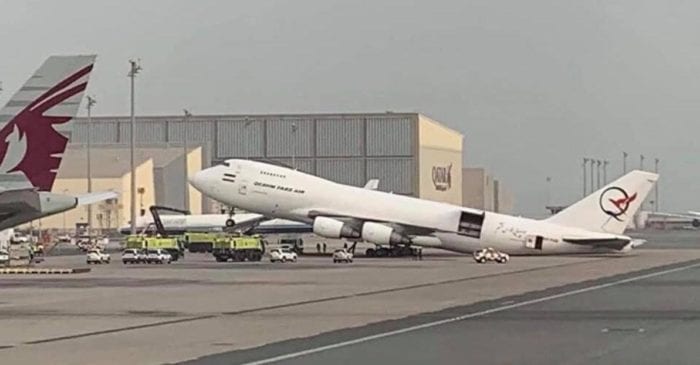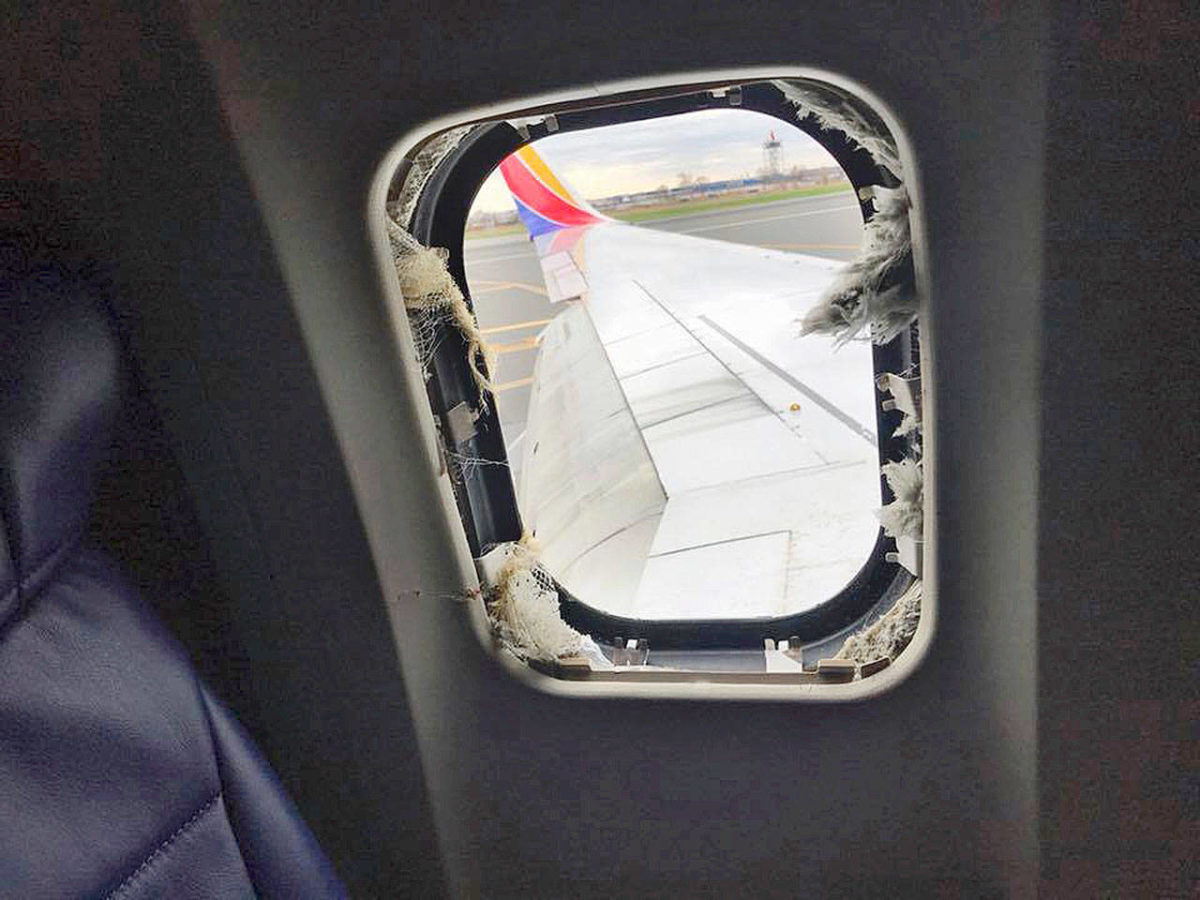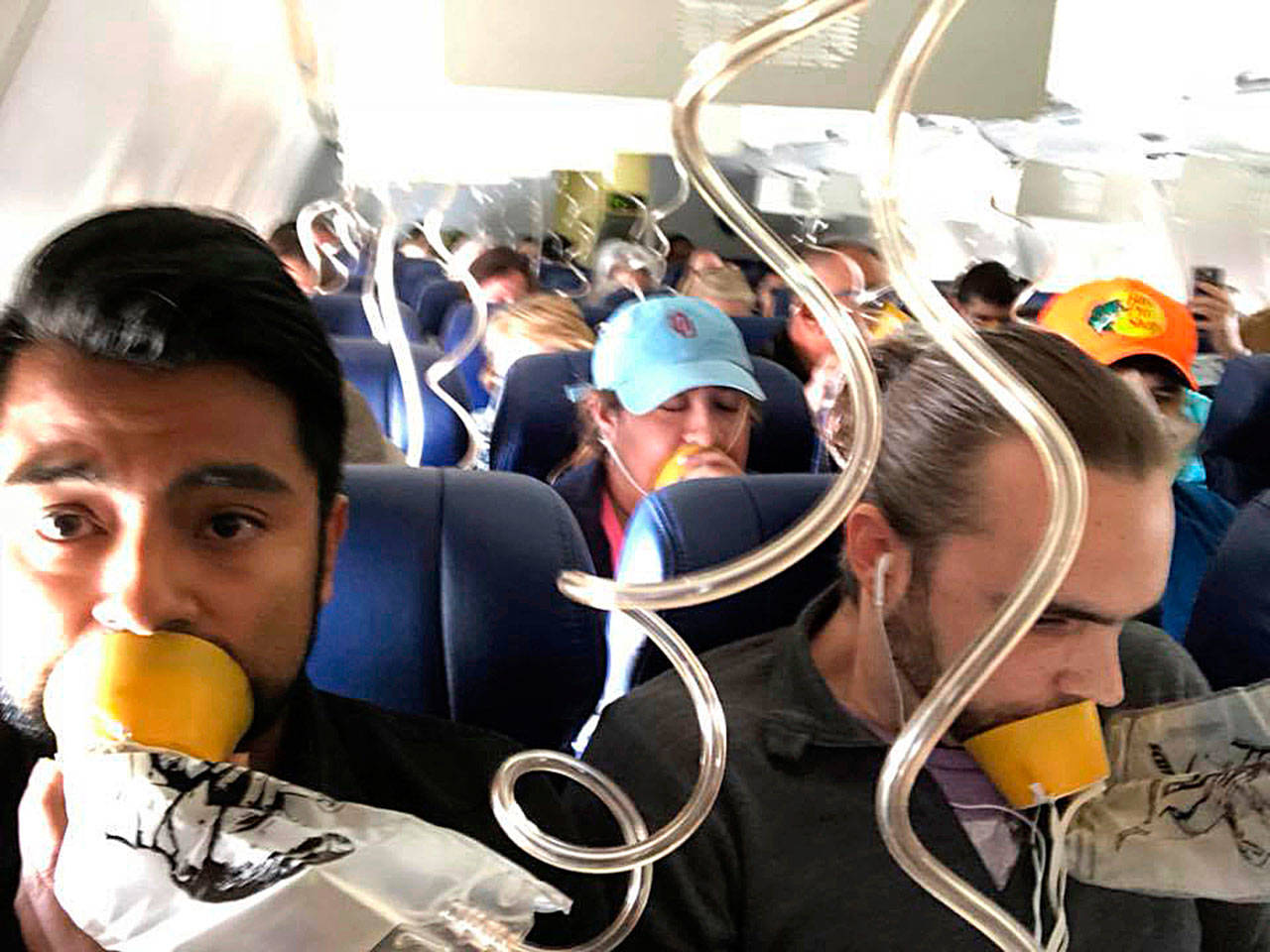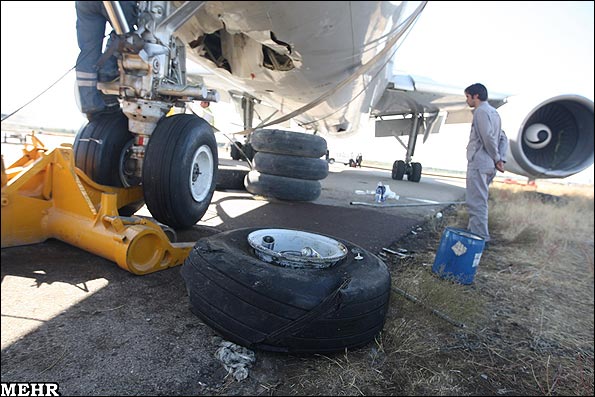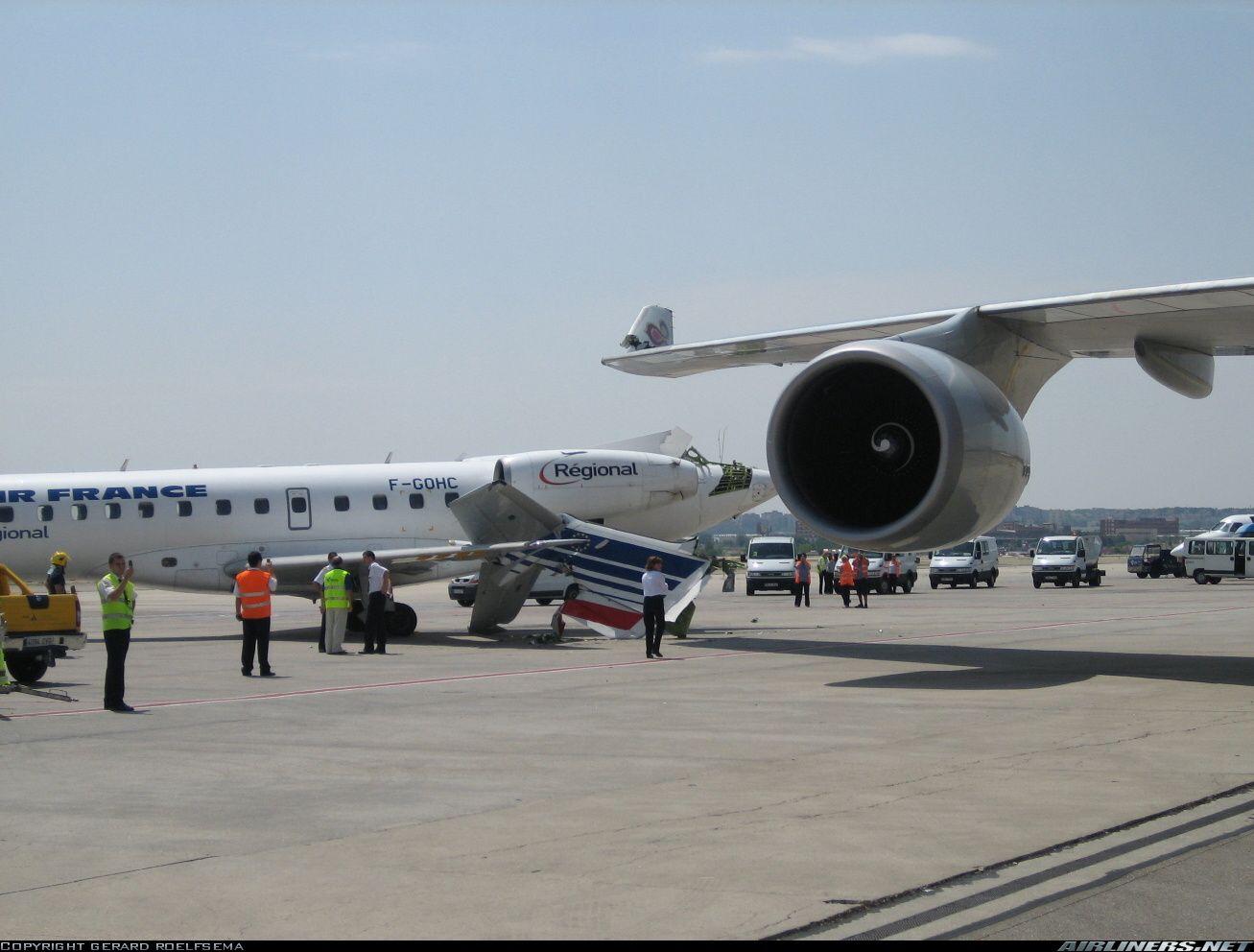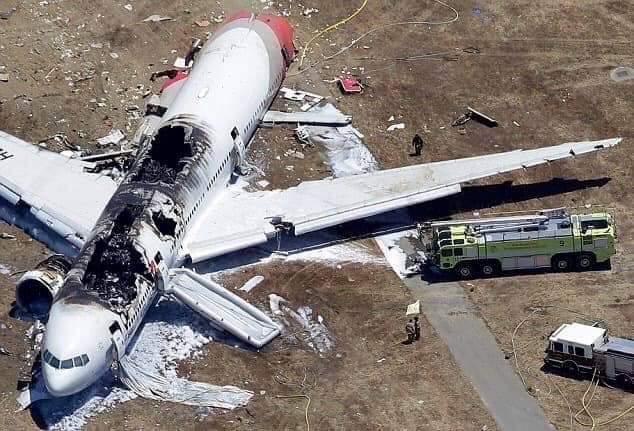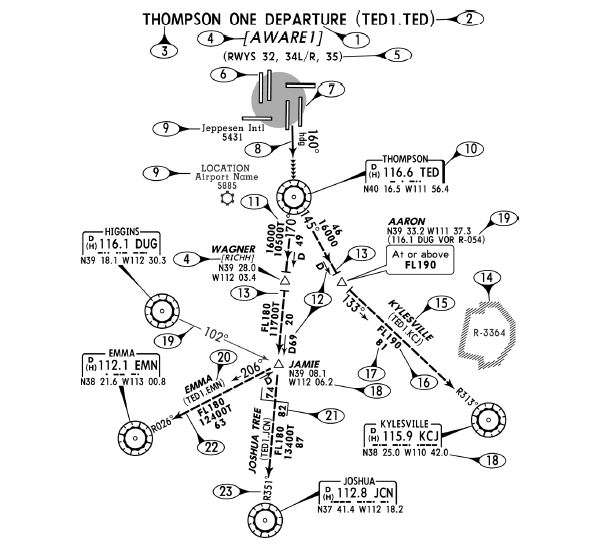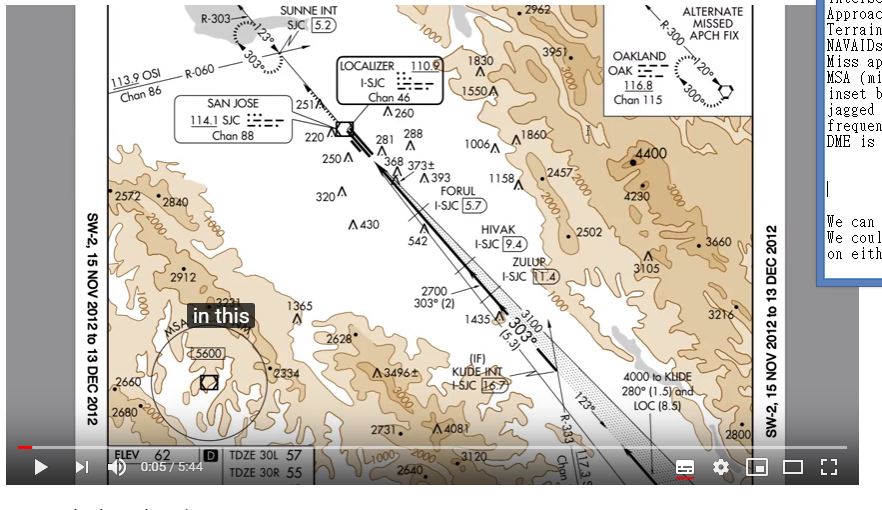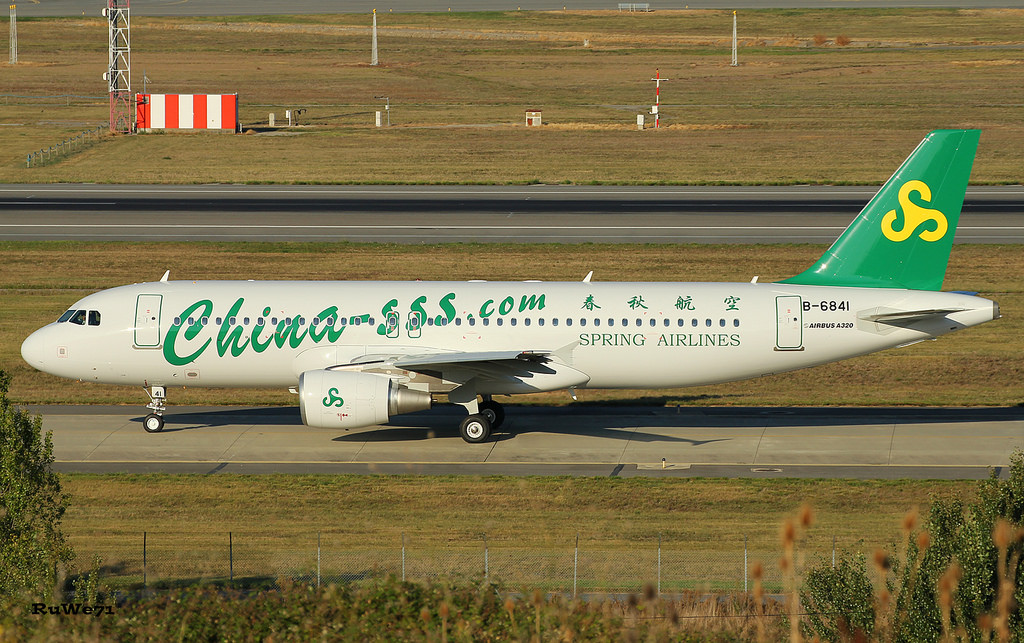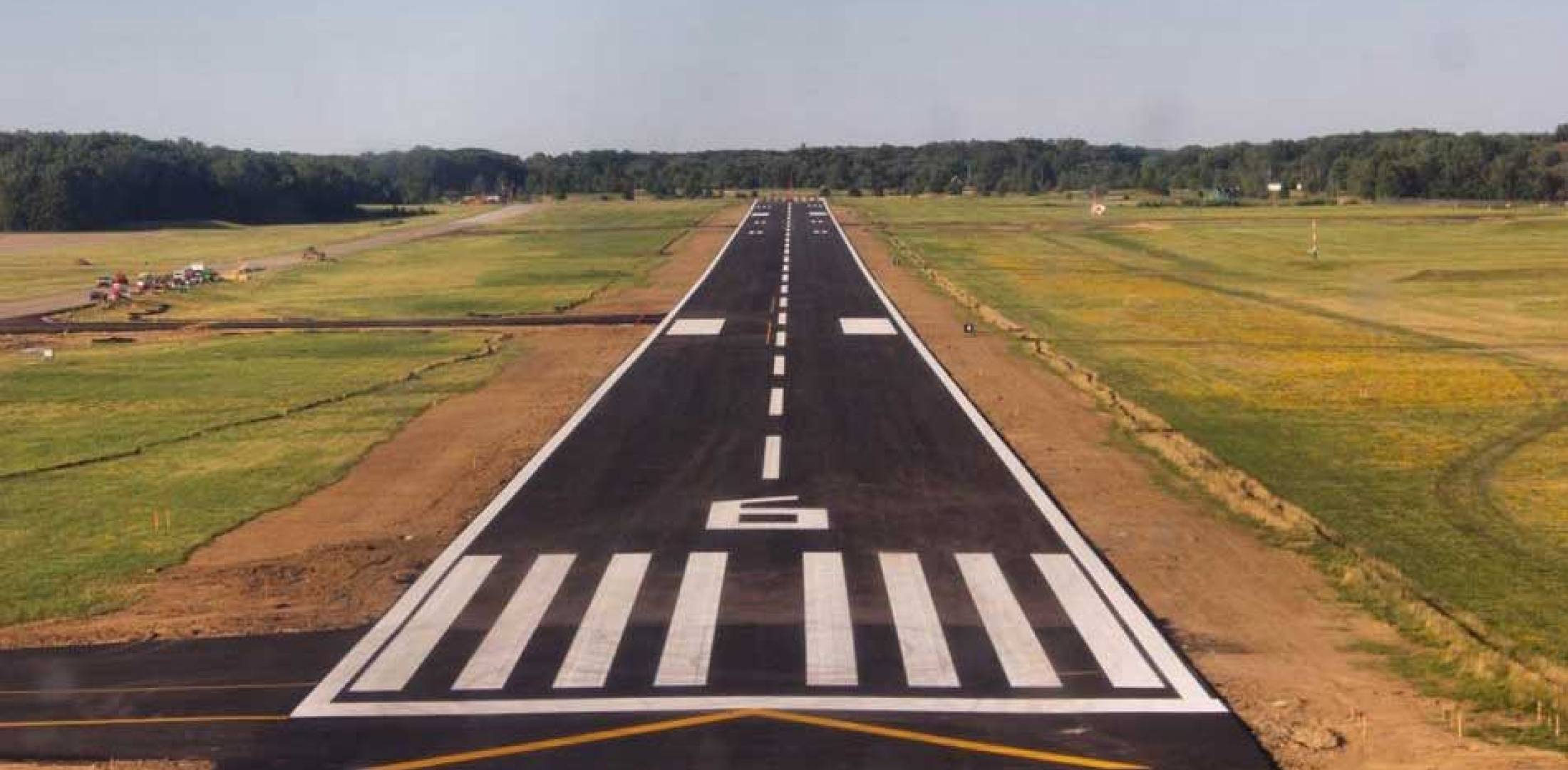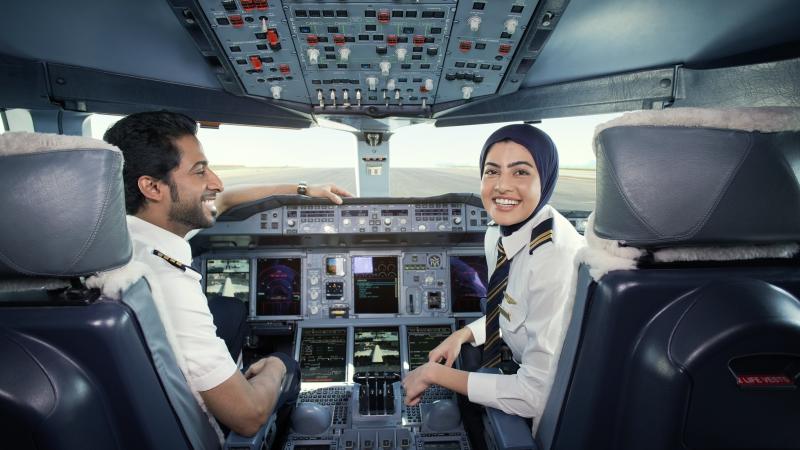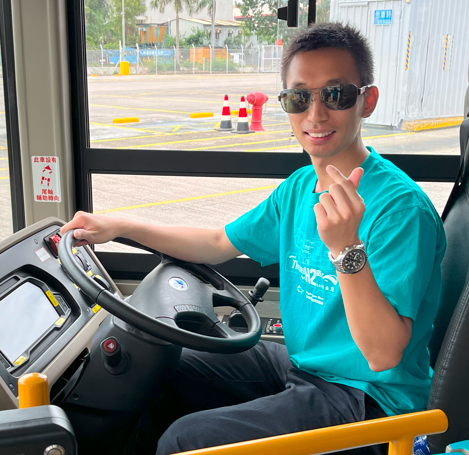ICAO English: Photo Description
Words bank awaiting to use:
I am looking at a picture of …
This is a photo of …
I think that this picture is taken in…
It looks like an Airbus in dispersal
It looks like fish of some sort.
emblem (n.) – e.g national emblem
has adopted the landing configuration.
in a tight sequence – the separation is small and the aircraft are quite close together.
tremendous disruption (n.)
come to a halt = come to a stop
skid off – skidded off the runway
slip off – had slipped off the runway
career off – (especially of a vehicle) to movefast and in a way that is out of control
The plane careered off the tarmac.
swerve to the left = come off the runway to the left
swerve (v.) 轉彎 – to turn suddenly to one side while moving forward
Firefighters douse the flames
Deformation (n.) 變形- usual shape changes andbecomes spoiled
be written off
In the wake of the accident
It’s quite a devastating scene.
there was an intense fire as the aircraft hit the ground
The blast and the fire were so strong that we couldn’t get near it and everything is burnt down
We cannot attribute the cause to
Everything was broken into pieces
at the scene
the nose pointed down and the tail raised up
farmland
saw billows of smoke and debris
crashed on the ground
slammed into another plane on airport tarmac
corporate jet
private jet
/////////
run amok (ph.) – to be out of control and act in a wild or dangerous manner
/////////
#Day 60
This is a photo of an aircraft wreck. The photographer was very likely standing on the starboard ring of the plane. In front of him on the left of the photo, we can see a man wearing khaki plain clothes moved his head inside the cabin from the over-wing emergency exit door. I guess that man was the photographer’s counterpart. Indeed, from that photo, we can only see from the part over wing to the nose and the aircraft were cut into at least three part, I can say that there are two “chop” – the aircraft is split at slight forward the leading edge of the wing and somewhere just behind the cockpit. Only the top half of the fuselage are visible – both the nose wheel and main landing gears are definitely ripped off. We can see that there are a bold red stripe covering the side of the fuselage along the longitudinal axis as well as around the passenger window. In addition, some text seems to be covered by red paint, so it is quite hard to distinguish which carrier owned the wreck or part-out modern airliner. On the right of the photo, we can see that the plane was laying down in a quite remote rural area with damp soil and grass. On the top of the photo, we can see that the sky was white which denote that it is covered by stratus cloud.
#Day 59
This is a photo of a passenger being delivered by charter flight. On the left of the photo, we can see two pilot and two paramedic were next to the passenger door on the port side. The pair of paramedic were sent from “St.John” and we can see this information/an emblem from their green uniform. The sick passenger was stretched with lots of survival equipment. The plane used in the operation is a cooperate jet with two tail-mounted engine. On the fuselage, we can see an azure blue and a red stripes along longitudinal axis, we cannot see too much about the plane since the position of the photographer. On the right of the photo is an ambulance with its rear door opened. In the background of the photo, we can see the hanger like structure – indeed, it doesn’t make sense to me since I am thinking how can the aircraft taxi to this position or how can the engine start if the aircraft are going to depart – the strong jet blast will definitely make damage on the structure. Therefore, I guess this is kind of photo for advertisement.
#Day 58
I think that this photo is taken in front of an isolated parking position (IPP)/ a remote parking stand. On the left of the photo is a Boeing 777-300 ER owned by Emirates, since these two information are known by the painting scheme on fuselage. In front of the modern jetliner, in the bottom right hand corner, we can see a luxurious racing car, which has a yellow body with some pattern on the bottom of its side. In front of the car, we can see the black chequered pattern as well as the word “follow me” imprinted on the hood/bonnet. If we look on the tarmac under the fuselage of the aircraft, we can see the parking standing centerline. By the port side of the aircraft, we can see a headset man, technician as well as the marshaller with luminous orange suit and safety wand. We can not see any wheel-chock as well as safety cone deployed. Therefore, it must just have come to stop. Behind the aircraft in the further distance, we can see a construction site with red and white chequered stone/concert jersey barricade in perimeter. Looking to the background, the sky was very clear with no significant cloud and in azure blue.
#Day 57

Source: https://www.asianage.com/metros/mumbai/100317/massive-mock-drill-takes-place-at-airport.html
I am looking at a photo of an aircraft catching fire. In the center of the photo, we can see a modern jetliner with hot pink at the lower part of the body and white at the upper part of the body. Also, we can see the radome in yellow, we cannot see the operator though. Indeed, the photographer was standing at 11 o’clock and quite far away from the aircraft. He and the aircraft were also likely to be on the unpaved area – the surface seems to be the dirt road. Looking back to the aircraft, we can see the billow of black and tan smoke dispersing toward the rear of the aircraft structure. There were fire fighters on both side dousing the middle part of the fuselage with water. On the left of the photo, we can see a group of people, they must be the surviving passenger evacuated from the plane. In the background on the left, we can see a line of fuel tanker. Lastly, from the top left corner, we can see that the weather was good with no cloud on the sky and it shows azure blue.
#Day 56
This is photo of a cargo terminal area of an aerodrome. In the picture, we can see that at least 6 modern freighter lined up on apron. In front of every parking stand, we can see a light mast. Those planes belong to various carriers – from UPS, Korean air, Aero Logic to the Hong Kong flag carrier Cathay Pacific. Indeed, we can see from the photo that there are Boeing 747, Airbus A320 family of some sort and the B77X. By the first three freighters from right to left, we can see that the passenger steps were deployed. Also, we can see a lot of shipment either in ULD or on pallet were placed next to those plane as well as in front those plane opposite to a double-way road for ground vehicle. Lastly, from the top right hand corner of the photo, we can see some haze and I guess the air condition was not good – it make sense particular in cargo field.
#Day 55
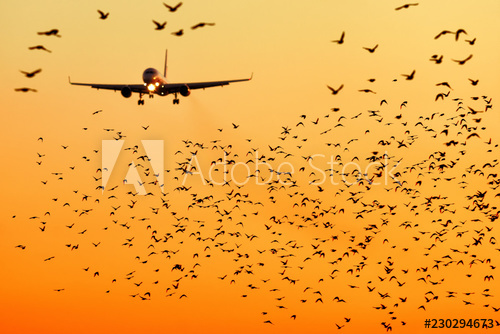
Source: https://stock.adobe.com/hk/images/modern-passenger-jet-engine-aircraft-landing-to-airport-runway-at-dusk-on-background-with-huge-bunch-of-birds-dangerously-crossing-glideslope-on-foreground-nature-transportation-birds-strike-close/230294673
I am looking at a photo of a modern jetliner approaching the runway. In the top left of the photo, we can see a widebody family of some sort has adopted the landing configuration with the gears down and the illuminating landing light. These means that the plane is definitely in final approach stage. It looks like the A330 series in dispersal from the contour of the wingfence. In the foreground, particular the right hand side of the image, we can see a flock of bird which is likely to pose a problem to the flight safety since they might lead to bird strike. From the background, we can see that the sky was clear in the sunlit condition which seems to be the dawn of dusk.
#Day 54
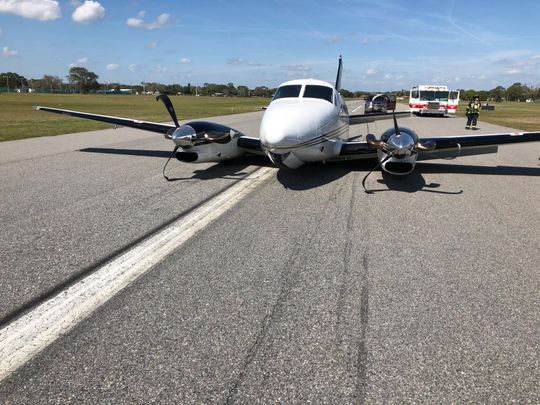
Source: https://www.floridatoday.com/story/news/local/2019/02/17/plane-makes-belly-landing-titusvile-airport-no-injuries-reported/2899498002/
I am looking at a picture of probably a corporate turboprop. The photographer was standing 11 o’clock of the the aircraft. We can see three stripe along the longitudinal axis of the plane with white fuselage, we cannot see the registration though. The plane was sitting on a pave road, it may be the runway or just a road for ground vehicles. The plane must have experience gear problem and the pilot make the gear-up landing. Since from the photo, we can see that the nose wheel compartment door was in half- opening condition. Both the propeller blade seems to be intact and so I guess the plane was landing in engine shut-off condition. Otherwise, it would has been bent. From the background, we can see that a fire fighter was standing behind the port side of the plane and behind him is a fire engine. On either side of the paved area is the medow with short grass. At far side, we also can see a tree-lined horizon. The weather was good – we can see the azure blue with few fair cumulus cloud.
#Day 53
This is a photo of a modern jetliner approaching to a runway of an aerodrome in a rural area. I would say that this is a composite illustration or the photographer was standing somewhere on a hill since he or she was located 5 o’clock below the aircraft. We cannot see any visual instrument for precision approach, at least we cannot see the localizer antenna, nor we can see the PAPI (Precision approach path indicator). In addition, we cannot see the aiming point marking. However, the threshold marking tells us that it suppose to wide enough for the plane in final approach. The only thing may make me concern is that the runway threshold is displaced which means that the pilot could not use the full runway length for rolling out after touching down. In addition, we can see that there are few hanger like building at the end of the runway while it is the residential area to the left of the aerodrome. Indeed, the end of the runway seems to be a slope – the aerodrome is very likely at relatively higher elevation than the city where has lot of buildings at low elevation. In the further distance/On the right of the photo, we can see a mountain which is located slight right hand side of the extended runway centerline. On the top of the photo, we can the weather was fair although a broken low level status was prevailing on the sky.
#Day 52

Source: http://www.aviation-accidents.net/flightline-fairchild-metroliner-iii-ec-itp-flight-flt400c/
This photo is absolutely taken in the wake of an aircraft crashed and caught intense fire. We can clearly see that the main landing gears were pointing toward the sky from the photographer perspective, we can only see a small part of wreckage though. It seems that the crashed plane was toppled. On the left of the photo, we can see the glide slop attenna as well as the non-prepared area which is very likely to be part of the side of the runway. Therefore, it would have been veering of the manuver area. From the bttom right hand corner, we can see the grass was covering with white foam. It would definitely be the extinguisher foam used by the fire fighters. Last but not least, we can see that the sky was fair during the photographer taking that photo. Indeed, a group of fire flighter like personnel with yellow helmet were behind the wreckage. They were very likely to be carrying out investigation.
#Day 51
This photo is definitely taken in the wake of runway excursion of a modern airliner. The photographer was standing somewhere 11 o’clock and slightly about the MALAYSIA plane with “LNJ” as part the registration. We cannot see the entire fuselage, we can clearly see the forward part from the nose to the L1 door. From the window appearance, it seems to be one in Boeing family. On the bottom of the photo, we can see a group of personnel were standing under the radome and I guess they were doing the investigation. From the distance between the radome and the head of the peoples, I feel that may be the B737 family. Since the sun visor was deployed on the port side window of the flight deck, we cannot see if there is any personnel inside while the L1 was closed. Indeed, the nose wheel seems to be connecting with the body still. In the background, we can see that the scene is a lawn with scrub and sparse vegetation/short grass. Lastly, in the top left corner of the photo, we can see a compactor as well as a military police with navy blue uniform and a crimson hat.
#Day 50
This photo was very likely to be taken in the wake of an aircraft incident on the date of 21 Feb 2007, as we can notice the timestamp/ watermark of date and time in the bottom right hand corner. The photographer was standing on the starboard of the plane and we can only see from the middle part to the nose of the modern airliner operated by the ADAM AIR. The fuselage had a orange paint scheme on the upper part and the lower part was in white. Interesting, we can see that there is a crack at the middle part of the fuselage and the part in aft was bended down. We cannot easily determine what happened only by watching on the photo. However, we should notice that the emergency chute at the forward doors were deployed. On the top of the image, we can also see that overcast stratus could was prevailing and looking on the bottom of the photo, we can quite sure that it was raining cats and dogs.
#Day 49
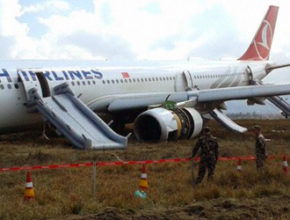
Source: http://www.aviation-accidents.net/wp-content/uploads/2015/03/turkish-airlines-airbus-a330-303-tc-joc-flight-tk726-.jpg
This photo was absolutely taken after a Turkish Airlines’ passenger flight encountering an accident. From the photographer perspective, we can see the port side of the plane from middle part of the fuselage to the empenage. Although it is quite hard to identify the registration as well as the model of the plane, we can clearly observe that three emergent chutes at aft port side were deployed. In the center of the photo, we also can see that the reverse thrust was used, if not the nacelle ripped open. From the bottom of the photo, we can know that the photographer was standing on the short grass and behind the corden line while there were to military police were noticed in the bottom right hand corner. On the top, we can see that the photo is overexposed to the sunlight, we can see the broken fair cumulus though.
#Day 48
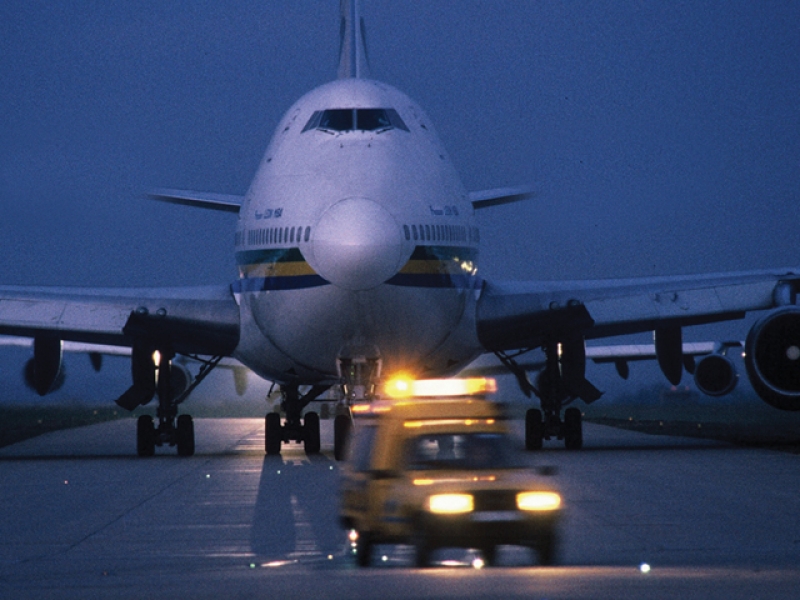
Source: https://www.eurocontrol.int/sites/default/files/styles/colorbox-max/public/illustration/sto-runway-incursion.jpg?itok=m7YzXeod
This photo is likely to be taken at the end of the runway or taxiway. In the center of the photo, we can see the modern jetliner behind a follow-me vehicle, which was turning to the left. The photographer was in front of the planes and the car. From his/her viewpoint, we can see that the yellow obstruction beacon of the follow-me car and the headlight came on while the taxi lights were on. From the background, we can see another aircraft in similar type was following the one in the foreground. On the top of the photo, we can see the sky was dark. It seems to be the time just before the dawn or just after the dusk.
#Day 47
This photo seems to be taken in a tourist hotspot. On the left of the photo, we can see an AIR FRANCE A340 was in final approach stage at just talking about 150 – 200 feet about the threshold. The photographer was standing in the crowd just like other vistors on the dune of a beach. He or she was facing the stardboard of the plane. In the bottom right hand corner, we can see others were also holding their portable devices to take the stunning scene. Also, there is a road which connect to the resort at the background of the image/ in the further distance. On the top of the photo, we can see that the daylight was prevailing with dense and overcast could on the sky.
#Day 46
This photo was very likely to be taken after an incident, if not an more serious accident. The photographer was standing somewhere 2 o’clock next to the nose of the plane. In the photo, we can see clearly the word “sirwejiya air” on the starboard forward fuselage and there are red and navy blue paint scheme along the longitudinal axis of sidewall. In the bottom left corner, we can see the engine on right was touching the grass. Indeed, the plane veered off the paved movement area. The forward right hand door’s emergency chute was deployed, so I guess that the crew carried out evacuation. Lastly, on the top of the image, we can see that the sky was covering with broken cumulus.
#Day 45
This photo supposes to be taken immediately/shortly after an intense fire related to a Thai’s modern airliner. The plane in photo seems to be the B737. The photographer was standing somewhere 5 o’clock of the plane. In the bottom left and right hand corners, we can see that two fire engines were spraying fluid toward the lower center of fuselage. On the top of the photo, we can only see billow of black smoke, we may notice from the top right corner that there is building behind those smoke though. Lastly, we can see that those black and tan smoke was coming out from both starboard aft and forward doors while there was flame (large fire) on the forward part of the plane.
#Day 44

Source: http://3.bp.blogspot.com/_IgdMjaJn1ys/TCBtcL3ggFI/AAAAAAAAABw/suiGLhQPzlY/s1600/UA744-HKG-02.jpg
In the center of the photo, we can see a modern jetliner with 4 engines were turning from based leg to final leg. The photographer were located somewhere above and behind the plane. In the background, we can see the aerodrome with precision approach equipment – PAPI (Precision approach path indicator). On the top of the photo, around the aerodrome is some water bodies – it seems like the sea and on the bottom of the photo, we can see the dense residential area. I don’t know why the photographer took this image, but we can we another aircraft on the taxiway. Rightly, the PAPI was showing 3 red and 1 white, which indicates that the aircraft was too low. However, some told me that it is not the case for B747. Having to say that the B747 like aircraft was using a quite stunning bank angle at a distance where it should have aligned with the centerline of the runway. Lastly, but not least, the runway threshold was replaced and so the overall runway length is quite short from my perspective.
#Day 43
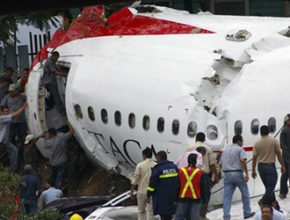
Source: http://www.aviation-accidents.net/taca-international-airlines-airbus-a320-233-ei-taf-flight-ta390/
The photo was absolutely taken in the wake of an aircraft accident. The photographer was standing next to the wreakage of the crashed plane. In the center of the photo, we can only see part of the left hand side of the fuselage fragment. On the top of the body has a red stripe and “TAC” three words was imprinted on the side below few passager window fames. Also, we can see the emergency exit door was opened and the middle part had been grazing with small holes. In the top left corner, we can see that few men were trying hard to maintain the door position while another group of people were standing on the wing area.
#Day 42
This photo is about the cargo compartment catching fire of JA829J. The photographer was standing at somewhere 2 o’clock and slightly about the aircraft. From the photo, we can see the rear part of the modern jetliner, we cannot see the engine and the fin though. However, it is clearly showing that there was white smoke coming out from the lower deck rear cargo hold. Therefore, it was very likely to be a fire incident on tarmac. In front of the cargo hold, we can see the ladder was deployed and a group of RAFF personnel were group there. On the left of the photo, we can see the fire engine parked behind the plane and there were few more yellow vehicle stopped at the rear port side of the plane. Lastly, in the bottom right hand corner, we can see the orange safety cone, I guess that the aircraft was definitely parking at stand for loading/unloading operations.
#Day 41
This photo was certainly taken after a B737 overrunning from runway. The modern jetliner was operated by KLM with the de-facto blue scheme on the fuselage as well as the logo on the fin. The photographer was standing at the starboard of the crashed plane which came to a stop close to a pool of water – that seems to be a sort of drainage canal. In the bottom left hand corner, we can see the unprepared terrain where the photographer was likely standing on. Look back to the plane, we cannot see any door was opened and so it may not carry out the emergency evacuation in the wake of the incident. Looking to the background, on the top of the photo, we can see the sky was clear with no significant cloud.
#Day 40
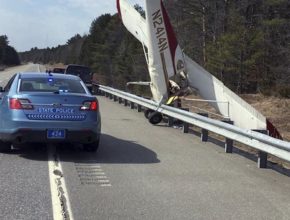
Source: https://storage.googleapis.com/afs-prod/media/media:87074731c88349a5bb02f6a70d76ae16/2000.jpeg
This photo was absolutely taken in the wake of a general aircraft crashed on the surface next to a road. On the right of the image, we can see that the N2414N had white fuselage with two crimson stripes along the longitudinal axis and the rear part of the fuselage also painted in chrimson, but we cannot see the entire empenage rightly. The aircraft’s tail was pointing to the sky and the nose was down. On the left of the photo, we can see the back of a police car which is in bright azure color. In the background of the photo, we can also notice the weather was good with altocumulus and the surface was dry. Since the aircraft remained relatively intact, it was likely to bump into ground a relatively lower speed.
#Day 39
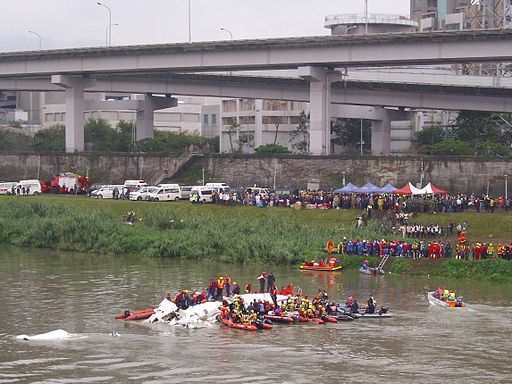
Source: https://engoo.com/app/daily-news/article/taiwan-pilot-cut-wrong-engine-seconds-before-crash/mqnRNL1lEeaKB2dXmItYlQ
The photo obviously was taken near an aircraft crashed scene. Rightly, it seems to be the TransAsia ATR crash accident. At the bottom of the photo, we can see a group of rafts were around the floating wreckage of the plane and some investigators or rescue personnel were standing on it. In the center of the photo, we can see the bank of the river which is literally the surface with short wild grass. From the left, we can see a row of ambulance and a fire engine. On the right, we can see various booths. I guess that there is somehow a road as well. On the top of the photo, we can see a dam like wall with two to three or so stories. About that is the elevated highway and a cluster of concrete building and structure. From this, we can guess that the crash definitely happened near the residential area or just inside the urban area.
#Day 38
The photo was absolutely taken in the wake of a GA crashed on grass. In the center of the photo, we can clearly see the plane in question has white fuselage and is likely to be classified as general aeroplane for training or tour visiting purposes. The empenage was badly damage as well as separated and the landing gear was broken down as well. Therefore, the plane’s belly was touching the surface. In addition, we can see some fragment around the wreckage. In the bottom of the image, we can see a group of people. Some of them is certainly the fight fighters and the other may be the investigator from transport department. Last but not least, we can see the fire horse was deployed.
#Day 37
This photo is obviously taken after an incident or even an accident. In the center of the photo, we can clearly see the wing-gear blowing-out. In the top right hand corner, we can see three technician wearing grey working suit were working on a jack. The surface was dry excepting an area in the bottom right hand corner, where we can see that it seems to be wet with with liquid.
#Day 36

Source: https://www.washingtonpost.com/news/worldviews/wp/2014/07/07/scary-near-miss-over-runway-at-barcelona-airport-video/?noredirect=on&utm_term=.4dcbc8ac83b6
In the photo, we can see the front of a modern airliner was approaching a runway at almost flaring altitude while a skyteam A340 was entering the runway. Obviously, the photo demonstrates the near-accident which two planes appeared to come uncomfortably close to a disaster. The plane in final approach phrase was powered by twin engine, we cannot identify the operator though. The A340 is definitely equipped with 4 engines in total and the sliver fuselage with the blue fin and rudder as well as the navy color over the wingtip giving us the hint. The runway edge light was up and the sky seems to be either at dawn or dusk. Last but not least, we can see the copyright information in the bottom right hand corner.
#Day 35
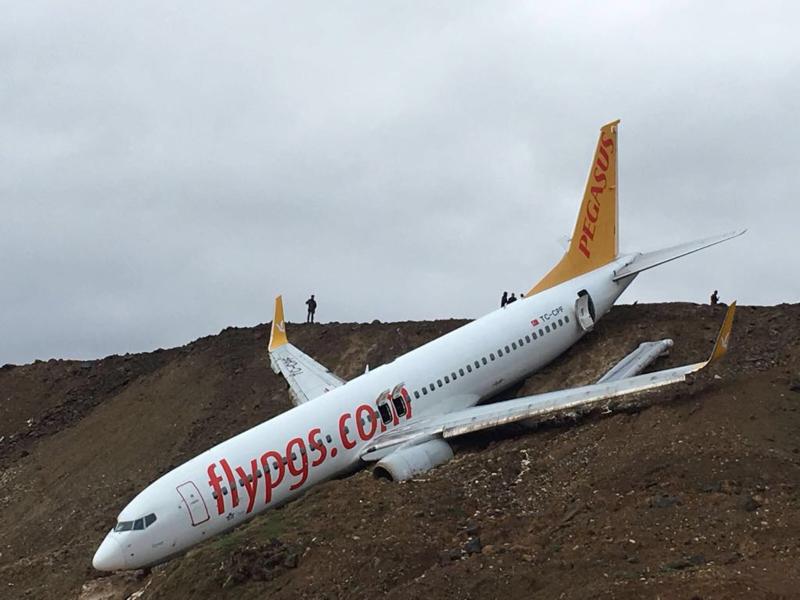
Source: https://meaww.com/turkish-passenger-jet-skids-off-runway-and-stops-within-metres-of-plunging-into-the-black-sea
The photo was certainly taken after a modern 737 crashed. The photographer was standing at 11 o clock below the plane. Rightly, the plane came stop at a slop with soil covering on it. The wing let and the dorsel fin help us to identify that is likely to be B737. Also, the Golden yellow on fin and wingtip as well as the words on fuselage and side of fin give information that was definitely operated by Pegasus.
From photographer’s position, we can clearly see the front was down while the plane’s rear was up (or the nose pointed down and the tail raised up) with over-wing doors and rear door of port side opened. At the top of the slope, we can see few people. Lastly, we can see the sky had densed stratus cloud in the backgroud on the top of the photo.
career (v.)
- (especially of a vehicle) to movefast and in a way that is out of control
The coach careered down a slope and collided with a bank;
The plane careered off the tarmac.
The plane skidded off the runway just metres away from the sea.
- to make something or someone wet by throwing a lot of liquid over it, him, or her:
We watched as demonstrators doused a car in/withpetrol and set it alight. - to stop a fireor light from burning orshining, especially by putting water on it or by covering it with something
Firefighters douse flames
#Day 34
In the photo, we can see an aircraft veered off (away) the runway and stopped on the grass at port side. The nose of the plane was at around 80 degree left to the runway centerline and the photographer was standing at 7 o’clock behind the plane. The Plane has an ivory color with two engines on each sides. Interestingly, there are 2 consecutive type D emergency exit door and there is a protrude pin-like structure toward front at the top of the fin. I cannot tell the model of the plane but I can see the string KC-137 2404 imprinted on the fin. The plane’s elevator as well as the empenage was over the runway paved surface, it veered off though. Below the elevator, we can see two Bulldozer and the “UN” words is clearly marked on the side of the plough-like machine. Around the aircraft there was various people were standing there – most of them were wearing olive green uniform and some were wearing the orange high-vis vest and blue helmet as well. In the background, on the top of the photo, we can see the azure sky with scatted alto-stratus cloud and few cumulus cloud.
#Day 33
In the center of the photo, we can see the push back tug and behind that is a modern jetliner with twin engine. From the starboard wingfence at the tip and the windshield of the cockpit window, we can guess that is one of the A320 series. Interestingly, the one to two stories buildings on the left of the photo and the grass area just behind the aircraft make it doesn’t like the sense in the aerodrome. Indeed, the rear part fuselage of the plane was cover by a group of tree and the main gear was likely on the grass. Although we can see some paved area at the bottom of the photo, I have no answer where it is. However, we can see some light that seems to be the reflective image from the window inside the shuttle bus. I guess the photographer was one of the passenger. Last but not least, we can see see white vehicles as well as the personnel with red high viability vest and yellow-over ear protection muffs were at the scene.
#Day 32
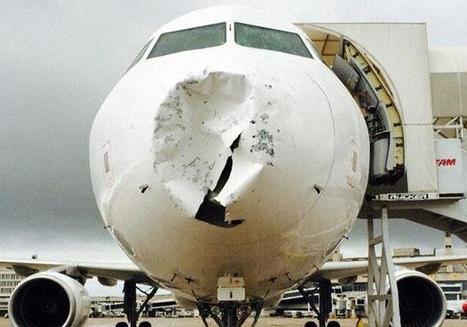
Source: https://www.scoop.it/topic/aviation-loss-log/p/4036979122/2015/02/10/asn-aircraft-incident-08-feb-2015-tam-hail-damage-airbus-a321-211-wl-pt-xpb
The photo was definitely taken after an incident and the photographer was standing in front of the modern jetliner. The Plane’s radome was dented with a same hold. On the port side of the photo, there was a passenger step deployed. Behind the plane is likely the terminal and so the aircraft was likely parked at remote stand. In the background, on the top left corner, we can see the weather was no good with grey stratus cloud. Should the incident caused by adverse weather, it may be the hail storm giving result to the damage.
#Day 31
#Day 30

Source: https://www.rappler.com/business/industries/171-aviation-tourism/30545-salvaging-cebu-pacific-aircraft-delays-davao-airport-operations-resumption
In the photo, we can see a Cebu pacific air’s aircraft veered off the runway and came to stop on grass. The photographer was standing at 8
o’clock of the plane and facing the port side of the fuselage. From that angle, we can see the web page domain of the operator. Also, we
can distinguish the carrier by the de-facto paint scheme, we cannot see the registration from the tail section though. However, In the center
of the photo, we can see two consecutive over wing type D emergency exit door. What’s more is that we can see the wing fence from the top
left corner, it is likely the airbus A320 series. On the bottom of the photo, we can clear see the runway was wet. The wing tip of the wing
was over the edge of the runway and below the wing has a fire fighter with one water hose standing by. In the bottom right hand corner, we
can see two survivors were standing on the runway. Rightly, we can clear see others was evacuating from the L1 emergency chute. On the top of
the photo, the sky was dark and it is certainly at night.
#Day 29
The photo obviously was take in the wake of aircraft incident or in a more worse case – accident. From the center of the picture, we can see the starboard side of the aircraft, which is a cooperate jet with a dorsal fin and long nose. The D-CAVA’s nose was pointing to the ground with its tail at relatively higher position. It is definitely toppled after the nose wheel was broken down. On the bottom of the photo, in which were the right hand side of the plane is the area with grass. In between, there were two RAFF cars. I guess that there were no immediate threat to the people on board or they had been evacuated and so the investigator arrived for inspection. Behind the photo, which mean on the port side of the plane, we can see that there were a row of tree under haze environment. Visibility was just fair and the sky was obscured with grey cloud rightly. From the angle of the photographer, we have no clue to see whether it was on taxiway or other area.
#Day 28
In the picture, we can see that a modern jetliner came to top at a plateau with the emergency chute deployed. The photographer was standing at 1 o’clock below the crashed aircraft. The right main gear was definitely broken down an so the aircraft tilted to the starboard side and I guess the engine was separated out from the pylon. Also, we can see some of the passenger was standing outside the plane. We cannot see the words clearly from the fuselage. What we can see is that the aircraft is white and with some olive green words and logo on the forward part of the fuselage and the fin. In the background, we can see the azure blue from the sky with few cumulus white cloud.
#Day 27
The photographer was standing abeam the starboard wing of a Ethiopian modern jetliner. Back to him/her was another modern commercial airliner. The photo is definitely taken in the wake of the ground collision. From the center of the photo, we can clearly see that the wing tip of the port side wing of the plane behind the photographer hit the Ethiopian right hand trailing edge of the wing tip. In the bottom right hand corner, we can see the push back tug and there are safety cones deployed along the the plane owned by Ethiopian airline. The tarmac was dry. In the background, we can see the cloud was obscured. Since the photo only shows us part of the wing of the plane which was located at the photographer’s back, we cannot make any further reasoning.
#Day 26

Source: https://aviationnews24.com/2016/05/28/korean-air-lines-evacuated-319-passengers-and-crew-from-an-aircraft-preparing-to-take-off-from-japans-haneda-airport-in-tokyo/
The photos is definitely taken after the B777’s starboard engine catching fire. The HL7534 was operated by the Korean air and we can clearly see that the plane stopped on the runway with two emergency chutes deployed. Four fire engine were facing the left hand engine, which had smoke coming out. On the ground, we can see a thin layer of foam that is likely the chemical solution used to put out the fire. Also, we can see that the runway was wet. In the top left hand corner, we can see a part of grass. We cannot see the sky since the photographer was at somewhere 11 o’clock and above the B777.
#Day 25
Tomb Sweeping Day
(Ching Ming Festival)
#Day 24
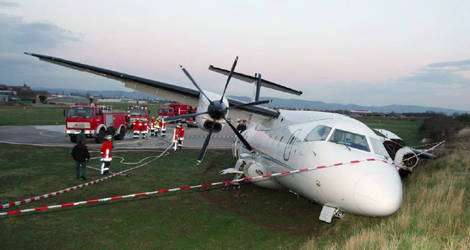
Source: http://www.aviation-accidents.net/wp-content/uploads/2015/12/cirrus-aviation-dornier-do328-110-d-ctob-flight-c91567.jpg
#Day 23
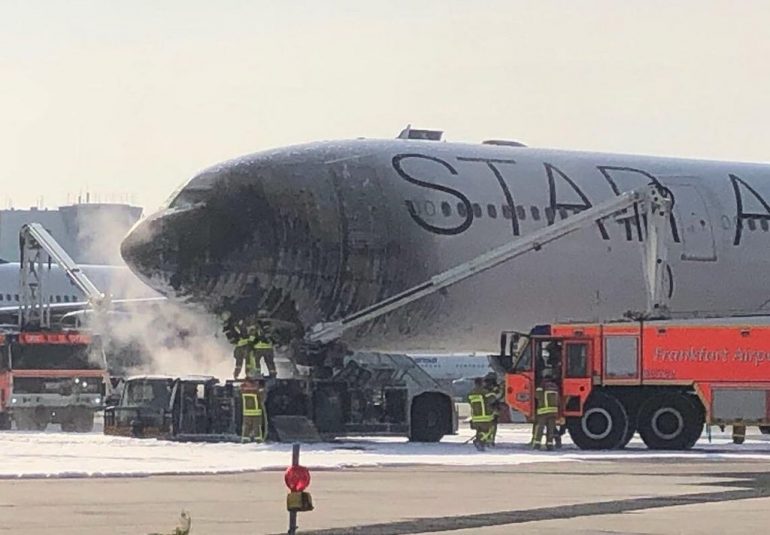
Source:http://newsinflight.com/2018/06/12/german-aircraft-accident-investigation-will-not-probe-the-lufthansa-a340-fire-incident/
The photo is likely to taken after a modern airliner caught an intense fire. The photographer was standing at 11 o’clock of the aircraft. From the center of the photo, we can see the forward part for the aircraft which have the star alliance paint scheme. We can clearly see that the area of fuselage near the cockpit and the push-back truck in front was burnt to black. Both port side and starboard side, we can see two fire engine with the crane like device. On the tarmac, we can see a thin layer of white bubble, I believe that the RAFF team used chemical solution to put out the fire. Look more closely to the nose wheel gear position, we can see two fire fighters climbed up to the top of the push-back tug. On the top of the photo, we can see the sky was obscured with white cloud.
#Day 22
This photo is showing the crashed “PK-LKS” operated by an operator called Lion. The photographer was likely to stand at 5 o’clock and little higher of the starboard of the B737-800. There are two ropes that tie the plane to somewhere on the coast. We can clearly see that the aircraft has been broken down into two piece and the rear part of the fuselage’s tail down slight more than the forward part. On the bottom of the photo, we can see some rocks near the shore and we can we the wide water body on the top. In addition, we can see that there were different layers of cloud and the lowest level maybe only few or broken and so we can see some sun light transparent through the cloud base. From the photo, it is hard to image the adverse weather would be the contributory factor of this accident.
#Day 21
The photo was definitely taken after a DHL freighter overran and skidded off the runway. The photographer was standing at 2 o’ clock of the plane, which has the former DHL paint scheme. The fuselage and the fin is golden and there are three red stripe along the longitudinal axis of the plane. Also, the big DHL logo is imprinted on the forward part of the fuselage. We can clearly see that the crashed plane veered off the runway and came to stop on the grass and the nose wheel was broken down, so its nose had contact with the ground and the engine on the starboard also touched the grass of non-movement area. I guess it is likely to happen on the port side as well. On the right of the photo, we can see a stair was deployed on the port side of the nose and on the starboard of the photo, we can see a group of airport personnel was clustering on the runway with yellow or orange high-vis vest. Also, we can see the rescues vehicle, which has a tale stripe on it. On the top of the photo is the dense overcast silver cloud.
#Day 20
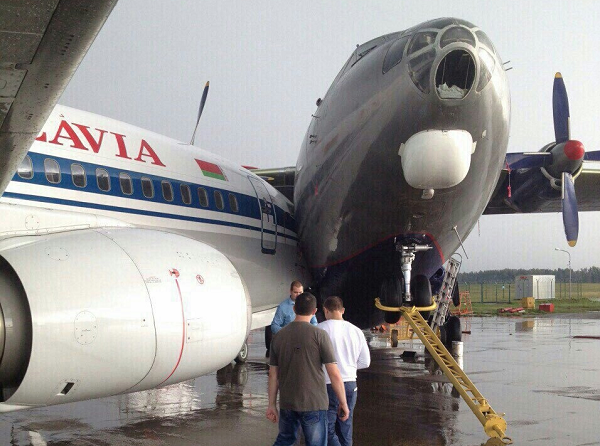
Source: http://www.jacdec.de/2016/07/13/2016-07-13-belarus-737-and-rubystar-an-12-ground-collision-at-minsk/
The photo clearly shows a ground collision. From the photo, we can see the photographer were standing below the starboard wing of a modern jetliner which bumped into a transport like aircraft which is powered by turboprop engines. It is quite hard to distinguish the owner of those two planes since we cannot see any registration on their fuselage. In the bottom left hand corner of the photo is the right hand side engine of the white plane. On the forward part of fuselage, we can only see a blue stripe along the passenger windows and above has imprinted AVIA in red color and next to that to an area more close to the ceiling of the flight deck sidewall is a nation flag with red and green horizontal bar. On the right hand side of the photo is the transport aircraft with grey fuselage. The photographer was facing it nose and the nose wheel was leaving the ground after the collision. There is a yellow stand used to fix the nose wheel and provide a contact point. Also, we can see a white protrude box below the nose of the plane, it is likely the radar. In front of the two planes, we can also see three man were standing there. In the background on the top, we can see the sky was overcasted with grey cloud base.
#Day 19
The photo is showing a devastating scene of an air crash accident. The wreckage is badly damaged and we can see the inner part of the starboard sidewall. Rightly, there is a big hold from the radome area to the middle part of the fuselage. The photographer was standing at 11 o’clock of the plane and there is a tree in the top right corner which partly block the port side of the fuselage, it is hard to distinguish the owner of that commercial airliner, we can only see some red text-line pattern. We also can see the empenage is T- Tail design with tail mounted engine. On the bottom of the photo, we can see a soldier like guard who, was wearing green, brown and khaki solider clothes. Behind that man and in front of the wreckage, we can see a yellow cordon line. On the ground, we can see lot of broken
stem and leaves of tree. Lastly, in the bottom right hand corner, we can a separate part. However, I cannot identy what it is.
#Day 18
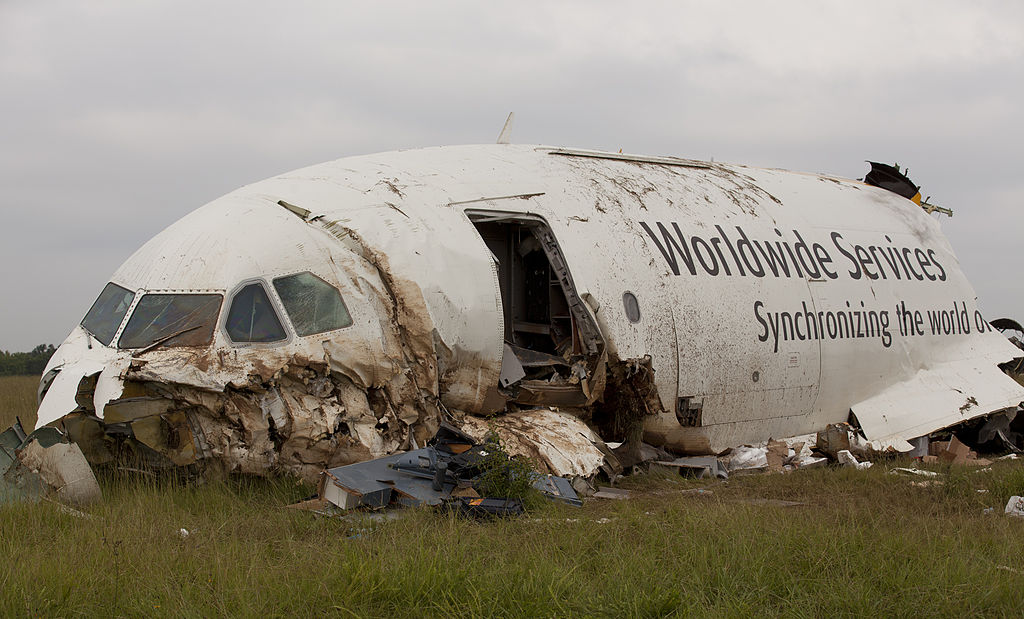
Source:
https://en.wikipedia.org/wiki/UPS_Airlines_Flight_1354#/media/File:Nose_and_forward_section_of_UPS_1354.jpg
In the center of the photo, we can clearly see the wreckage of an UPS aircraft laying on the short grass. The photographer was standing at 11 o’clock and level with the cockpit when he was taking the photo. The wreckage is not the whole body of the plane, instead it is just the substantially damaged nose and forward part of fuselage. On the side wall of the fuselage, we can see few words “Worldwide Service services synchronizing the world. In addition, we can see an small area is in brown and golden color. That was why I said it is likely the crashed UPS aircraft. Of course, it might be just part out and this part come to that location. However, it seems to be crashed. We cannot see any undercarriage as well as the nose wheel, which mean the belly of the plan was touching the surface. One more thing about the aircraft is that we can see the service door which size is similar to the passenger door in the center of the photo. Yet, next to it on the right of the photo, we can also see a cargo service door, it was definitely a freighter. On the background and top, we can see the sky is overcasted with ivory cloud.
#Day 17
In the center, we can clear see that the crashed aircraft came to stop in a forest. The airplane received substantial damage,the fuselage broke up in two parts. The photographer was standing at 7 o’clock and approximately 20 meter away from the wreckage to take this photo. We can see the fuselage is in white color and there are some words on the side and we can see part of the registration – PK-MD and we cannot see the last words though. The dorsal fin indicates that is likely a Boeing 737 series and we can see the azure and three yellow bold curve pattern in the middle of the fin and the pattern placed horizontally.
In the bottom left, we can see a flock of people there, some of them were wearing yellow shirt and others just as civilian attire. I guess some of them are rescue personnel. On the top of the photo, we can see dense tree and so, the scene may be a forest or a river.
Speaking of injury:
passengers received critical injuries/serious injuries/minor injuries
minor injuries
# Day 16
The photo is a devastating crash scene. On the right of the photo, we can only see the tail section of a crashed aircraft, which had the t-tail design. Since there was an intense fire and the lower part of the rudder is severely damaged. On the upper part of the fin, we can see the pale azure in background with some white star on it. In the center and on the right, there were two cranes at the scene to assist the rescue. In the bottom left hand, we can notice a group of fire fighter grappling the hose at to standby for re-ignition, I guess. In the background, we can see a house behind some grass with straw color. The sky had broken cloud and we can only see the shape of the hill at far distance.

Source: https://www.usatoday.com/story/news/world/2018/09/28/air-niugini-plane-crash-micronesia/1453064002/
The photo is definitely taken after an aircraft ditched into a water body. We cannot clearly identify the operator since we cannot see the lower part of the modern airliner was immersed under water. The photographer was at seven o’clock behind at least 50m from the aircraft. The fuselage and fin of the plane are in white color and we can see a curved pattern in read and maroon color. Around the plane, we can at least 8 canoe at the scene to help the survivors escaped from the plane. In the foreground, we can see a island in the top right corner and the sky is full of dense cloud.
# Day 15
This is a CNN news photo about collision of two general aircraft. In the center of the photo, we can clearly see that a bigger business jet crashed into a smaller one. On the ground, there is two yellow solid line and there is some green aera on the top of the photo. I guess two pilots of the aircraft were taxiing on the maneuvering area. However, either one of them did not give way to another resulting in this collision. Or in other possible reason is poor communication.
Both aircraft in the photo have T-tail horizontal stabilizer. The bigger business jet is equipped with two tail-mounted turbo-jet engine,which collided into the port-side rear part of the smaller business general aircraft equipped with two-wing-mounted propeller aircraft. After the collision, the left wing gear of the smaller aircraft were leaving the ground with the trailing edge of its port side wing hanging on the fuselage of the bigger one.
Around two aircraft, we can see various safety cones were deployed next to the wings, tail and even belly. At 11 o’clock of the bigger aircraft, I mean the one with a blue stripe on fuselage along the longitudinal axis and the fin- on its, 11 o’clock has a white jeep and two o’clock is the RAFF vehicle in yellow color. Also, there are 5 people at different position near two aircraft. I reckon that they were doing some preliminary investigation at the scene.
# Day 14
In the foreground, we can clear see the wreckage of a modern jetliner of China Airlines was parking on the tarmac. The nose is to the right on the photo and we can see that the emergency chute was deployed on the starboard forward door 1R. We can also see a person wearing bright orange uniform near the door. In addition, the tarmac was still wet with liquid and foam. I believe that the photo was taken in the wake of an incident/accident and the intense fire had been just put out. Looking back to the aircraft wreckage, we can see various ladder was deployed – two at front and one at the rear. From the area just after the cockpit to the middle part of the aircraft, we cannot see the ceiling, I reckon there is a big hole leaving after the intense fire. Indeed, we can see that the middle part was burnt down and the aircraft’s belly was touching the ground. It is likely to have no undercarriage supporting it, perhaps the fire was so strong. Overall, the forward part and rear part were remaining intact. From the dorsal fin at the rear and the nose wheel compartment door, we can guess that it a boeing 737 aircraft. Last but not least, we can see there is ground operations on the port side gate. The incident seems not affect other aircraft.
# Day 13

Source:
https://upload.wikimedia.org/wikipedia/commons/f/fe/2019_Saha_Airlines_Boeing_707_crash_03.jpg
In the photo, we can see the wreckage of the empennage and rear part of a crashed aircraft. The fin and tailplane sections are badly burnt into darkness. On the right of the photo, we can see that is residential area with few houses. It is definitely a village. The wall of the structure was burnt and leaving some grey ash. At the bottom of the photo, we can see a cluster of rescue and investigation personnel at the scene. Some of them were wearing orange or yellow uniform and others were wearing shirt. In addition, we can the landing bogie was torn apart to few meters from the fuselage or wing. Since we can see that those houses were barely burned and remaining in contact. We cannot see the wing and the front part of the aircraft. It is likely that the aircraft were broken into various part and the rear part collided into the houses.
#Day12
In the middle of the picture, we can see an airbus modern airliner on the runway with sparks shoot out from N536JB’s front wheels. Obviously, the operator is the american-based LCC – jetBlue as its livery shown. There are total in four emergency exit doors on its port side fuselage. 2 among of the 4 doors are over-wing type-D exit door in near position. If it is not an A320, then it would be the A319 series. I guess the aircraft was likely to abort the takeoff or in another cases, such as overweight landing. At the bottom, we can see the taxiway ST. This information is told by the location signpost. In addition, we can see the runway direction signage 07R and 25 L as well. From that, we can know that the aircraft was using the 25L for deacceleration since its nose as on the left of the photo and the right hand side of the signage is 25L. At the top of the photo, in the background has a hanger. Inside the building, we can see an american nation flag in the top left area, we can see the Australian-based flag carriers on two aircraft’s fin in the top right corner though. The scene seems to be in one aerodrome of America since no LCC would like to operate flight for long-haul flight and the range of any A320 variants seems not to long enough to cross from Australia to North America.
#Day 11
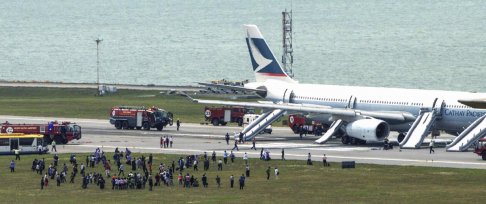
Source: https://amp.scmp.com/magazines/post-magazine/article/1491534/pilots-reveal-death-defying-ordeal-engines-failed-approach
On the right of the photo, we can see a Cathay airliner was stopping on the runway with 4 emergency chutes deployed on its right hand services doors, we cannot see the nose though. The starboard engine is slightly longer and so the aircraft maybe A330. At the bottom of the photo, we can see the non-pavement as well as non-maneuvering area – that is the grass area on either side of the runway. A flock of people was gathering there, I guess it is defenitely the evacuated passenger form the plane. On the right of the photo, we can see the passenger bus since it is in yellow on its top. Also, we can see 4 RAFF vehicles horizontally deployed behind the aircraft. At the top is the sea. On more thing is that, we can see a serial on ground just near the rear of the aircraft. Should that is the ILS glide path slope signal antenna, then the aircraft was definitely stopping just with 300m or so to the end of the runway of its landing side. Pilots are well trained not only for normal operations, but they also have to show their airmanship and competence particular in abnormal and emergency situation. It is not a easy job, isn’t it.
#Day 10
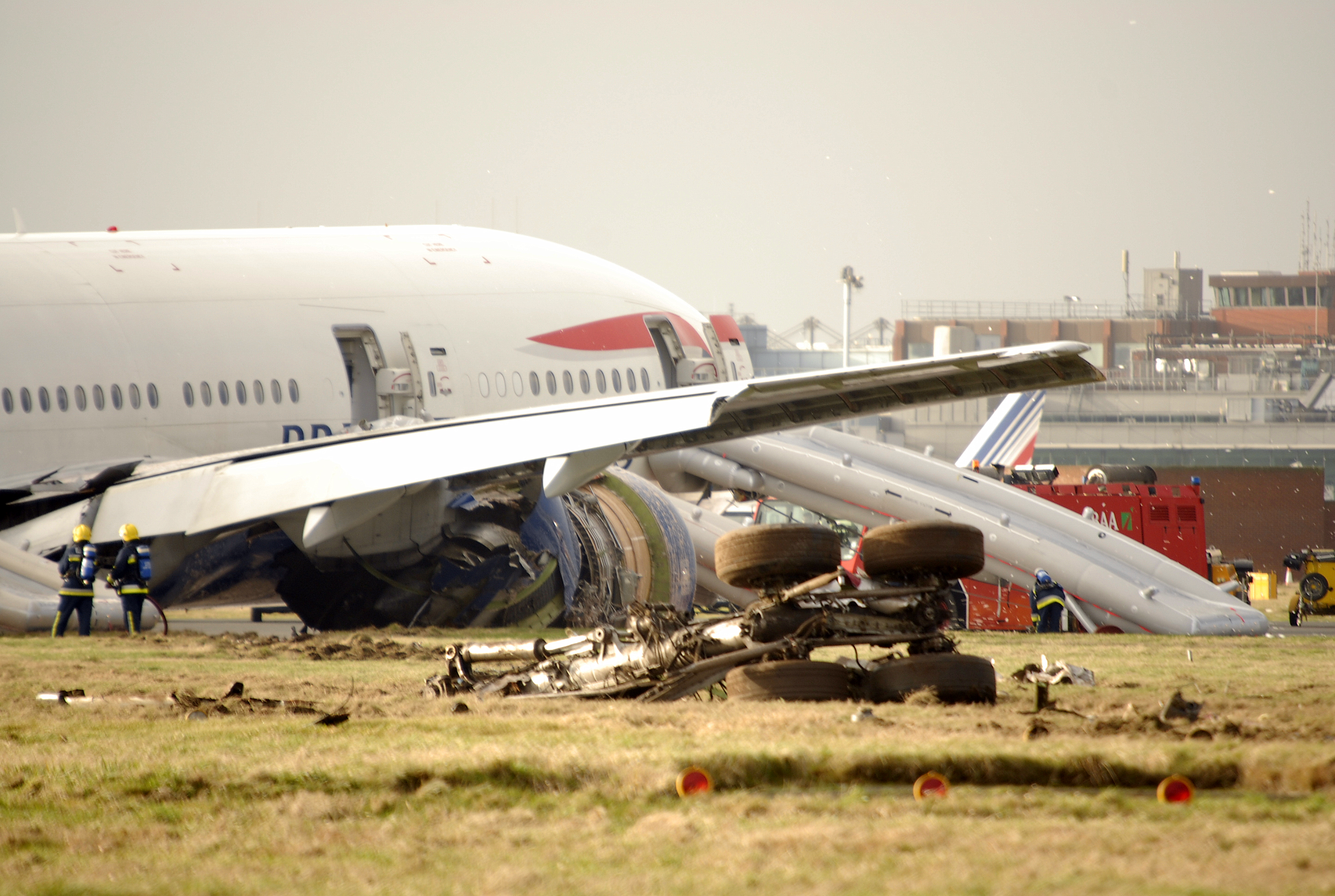
Source: https://www.google.com/url?sa=i&source=images&cd=&cad=rja&uact=8&ved=2ahUKEwi29cyC75HhAhVZMd4KHbbEAfcQjRx6BAgBEAU&url=https%3A%2F%2Fen.wikipedia.org%2Fwiki%2FList_of_accidents_and_incidents_involving_commercial_aircraft&psig=AOvVaw1dEXtso3W0vEZpKtnHi4Jf&ust=1553210721432352
On the left of the photo, we can see an modern jetliner crashed. The photographer was standing on the grass at 4 o’clock of the aircraft and he took that (this) photo at lower angle. We can see the grass of non-movement area and give us sense of runway excursion after main gear broken apart. At the bottom of the photo, we can see a gear bogie with 2 pair of 2 wheels laying on the grass. As we cannot see the runway or any indicator of pavement area for a jet – that should be in grey color. In the center of the photo, the starboard engine with a blue cowling was apparently damaged badly. Also, we can see two forward right service doors were opening with emergency chutes deployed. On the right hand side, we can see a red structure seems to be the ground tower building. On the top, the sky was overcast.
#Day 9
In the center of the photo, we can see a Boeing 747’s tail tipping backward on the apron near the warehouse, I mean the cargo terminal. The semi-double decker‘s rear cargo door was opening. I don’t know what’s the name of the operator, but I can see a circle and a “V” shape in red on the fin. The apex of the “V” shape was pointing to the nose of the aircraft, which is on the left in the photo and the color of the fuselage is in white. On the left of the photo, we can notice that there was another aircraft parking on its portside. I see the logo of a Doha based flag carrier – the Qatar logo the aircraft ‘s fin. I guess the scene is the cargo field where is designated for loading and unloading. Lastly, we can see various RAFF – Rescue and Fire Fighting Service’s vehicles on the scene. I remember when I was still a ground handling agent, my senior taught me that several series are more prone to tipping. However, having to say that, we should always follow the Standard Operating Procedure (SOP) to reduce the risk as low as practicable.
#Day 8
Source: https://www.nbcnews.com/video/fire-smoke-seen-from-american-airlines-flight-383-796023363984
There is a modern jetliner which nose is on the left of the photo and tail on the right. We can see three emergency exit chutes including one overawing slide was deployed. I guess it is definitely because of the fire at its starboard. I cannot sure which part of the aircraft was catching fire, but it seemed to be coming from the right engine since we can see some fame from the bottom at the middle of the plane. In the bottom of the photo, we can see the passenger were standing on the grass. I believe the captain executed the emergency evacuation. In the top right hand corner, we can see the dark smoke, which just like what we are likely to see after the demolition of explosion. In the top right corner, we can see the sky was overcasted during the occurrence of that episode. Lastly, fire is vary likely leading to life threatening situation. That’s why every modern aircraft for passenger transportation purpose must be test that the occupants should be evacuated within 90s in the drill.
The photographer obviously was focusing on the modern jetliner that caught fire on its starboard engine. The witness was taking the photo at 11 o’clock below. Neither we can see the left or right wingtip, we can notice its shape and that is a twin engine jet with three landing bogie on each side. I guess that is the B777. In the photo, we also can see the taxi light or the “landing light” on the nose wheel gear was on. However, the most eyeball catching in the photo should be the fame and smoke at the tail of the right hand engine. Lastly, the background shows the sky was overcasted.
#Day 7
The photo is definitely taken after an episode of aircraft incident/accident. In the center of the photo, we can clearly see the port side wing from the cabin windows. The windows glass was broken (shattered) and leaving a hole with some clothes-like material around the frame of the cabin window. From the photo, we could understand that there are at least two layer of glass to be seen in a normal aircraft. This is hinted by the thickness of the edge. Looking outside from that windows in that photo. We can see the flaps was extended to a landing-like configuration. Also, we can guess that had just stopped on the runway. Last but not least, the inner wingtip has 3 vertical strip, from left to right is in color blue, red and yellow. This photo helps me thinking of the terrifying explosive decompression accident of a southwest flight.
The photo shows a group of passenger were donning the oxygen mask dropped from the overhead compartment. The photographer apparently was seating at rear starboard side window seat. On the left of the photo, we can see a man, thirty or so, with a sideburns haircut. I guess he was using his PED (Portable Electronic Device) to taking that selfie to record this terrible moment. The man next to him was a male with a bun and looking down. Behind him was a women wearing a blue cap who closed her eyes with one hand holding the yellow mask. Last but not least, on the right of the photo, we can see an other passenger setting on the port side were holding a PED. The photo is blur and gives you with an angle. I guess the cockpit crews were trying to doing an emergency descent to lower safe altitude after an explosive decompression.
#Day 6

https://i.stack.imgur.com/BPCD3.jpg;
https://aviation.stackexchange.com/questions/39389/is-excess-fuel-leaking-normal-during-take-off-of-a-b737
There is a modern jetliner in the photo, the photographer was facing the starboard of the aircraft, which nose was on the right hand side of the image, we can only see the fuselage without cockpit and empenage section though. In the bottom right hand corner, we can see a fuel bowser since there is a well know (de facto) brand “airbp” imprinted on the vehicle body. The fuel truck was heading to the rear part of the aircraft and parked in front of the leading edge. There were two personnel wearing high visibility vest standing in front the starboard wing. It is apparently that fuel was spilling from the wing tip area. The fuel piles was connecting to the fuel entry port under the wing, but I guess that they have already stopped the fuel supply. On the left of the photo, we can see that an Italian national flag as well as the registration “I-NEOS” on the rear of the aircraft with blue livery. In the background, an overcast cloud was noticed, although I don’t think that the incident related to weather condition.
#Day 5
I reckon the photographer of the image was standing in front of the nose wheel gear and under the radome. In the picture, we can only see the low part of the nose wheel on the left and the port-side engine on the right. You can also see some grass in the right hand corner. The aircraft was at angle and I suppose the nose was heading away from the centerline of the runway or taxiway. Therefore, it very likely to be a runway excursion. Also, I guess that the modern airliner had nose-wheel tyre bursting after veering off the pavement maneuvering area. There is a yellow jack uplifting the nose wheel and a technician was standing on the right hand nose wheel. Also, we can notice the area just rear of the nose wheel had been badly damage with a hole. I guess that was hit by the broken tyre at the bottom of the photo.
#Day 4

https://www.airport-suppliers.com/supplier-press-release/bird-strike-prevention-risk-assessment-and-reporting-beyond-the-aerodrome/
In the center of the photo, we can see a narrow-body aircraft, which seems to be a B738 airliner. It was rotating from the runway surface. The photogrpher were standing at 11’o clock below the aircraft and got a full view of the aircraft, from right wingtip to the left wingtip of the aircraft. From the photo, we can see the no.1 engine had flame coming out. Also, we can guess that the contributory factor of the left hand engine flameout is bird ingestion. On the right of the photo, we can see a flock of brid were assembling on the port side of the aircraft in question. Look into the background, at the bottom, we can see the runway surface was damp. At the upper part of the photo, a cluster of building of a town were coving by a layer of mist.
Technical Study
Should the bird were acting as FOD (Foreign Object Debris), the port-side engine of that aircraft was very likely suffing from compressor stall. If the outlet pressure drop below normal level, it means only a portion of fuel gets burn, the very hot unburnt fuel which escapes through the combustion chamber will meet the oxygen rich bypass air and there will be sudden combustion.
#Day 3

https://www.mro-network.com/maintenance-repair-overhaul/cold-facts-aircraft-maintenance-teams-extreme-weather
The photo gives us a sense of chill. In the foreground and left bottom corner of the photo, we can see the rear part of a modern airline from the leading edge area of the wing to the empenage, there are snow accumulated on the top of the fuselage and even on the upper surface of the sweep wing. On the port side of that aircraft, we can see a bowser and some piles connected to the lower surface of the port side ring. And at the rear compartment, we can see the belt conveyor was deployed and we also can see a passenger step was deployed at the far-rear door of the left hand side. On the right of the photo, we can see two small vehicle and one passenger bus were behind the aircraft. In the background of the photo, we can see different type of commercial airliners, including narrow-bodies and wide-bodies, were parking in font of the terminal and some were parking at the remote stand in top right corner. Although the surface of the apron area was covering by white snow, we still can see that some trace of vehicle footprints in pale grey color. Overall, I believe that the ground operations was not affect by the snowstorm. This type of adverse weather is extremely rare and uncommon in Hong Kong or south east Asia. Indeed, you can see the German’s nation flag and the Lufthansa logo on the aircraft at the bottom. I guess that photos was taken in one of the aerodrome in Europe.
#Day 2
The photo should be taken on the apron after a collision associating with two aircraft. From the photographer standpoint, on the right should be a wide-body jet operated by Thai airways. In the middle of the photo, we can see the tiny logo on the inner surface of the winglet and obviously that is damaged on the leading edge of the wing tip area. The reason why I said that is a big jet because of the engine as well, we can clearly see one of the engines and the spiral shape printed on the cone at the middle of the startboard engine, we cannot see any other part of the aircraft though. Moving you attention to the left, you can imagine that the photographer was facing the port side of the other aircraft involved in the incident. That should be a regional jet with a tail mounted engine. And the owner or lessee should be the AIR FRANCE. On the left of the photo, you can see a the middle part of the aircraft and there is a text string on the fuselage – bolded and navy blue text string : R FRANCE and you could also see the registration imprinted on the tail is F-GOHC. The aircraft seems to be severely damaged since you can see the fin and horizontal stabilizer is missing as well as separated from their correct position onto the tarmac at the port side. These two aircraft in question make the photo divided into two parts, at the lower part of the photo, we can see large portion of the pavement like the concrete structure. In the front of the photographer, there are different personnel. From the left, you can see one who was wearing the high-vest in yellow color who was holding a device and facing the Thai airliner while the other one next to him was facing the AIR FRANCE one. Slightly moving your eyeball to the right, you can see three more were circling in a group who seemed to be discussing. In the middle of the photo, interestingly, you see a people who was facing the separated part as well as wearing a write shit and black trousers without wearing any high visible vest. On the right hand, a series of vehicles were parking behind the aircraft horizontally. Lastly, the upper portion of the photo, we can see the sky in pale blue with few cloud. This photos just reminds us incident could happen any time and so pilot should be always in vigilance to prevent any one. One more command from mine is that we should always wear the high visible vest in the apron area, otherwise, you may not be identified in low visibility condition such as night time or in pea-soup day.
# Day 1
The photo was obviously taken at the accident site associating with aircraft. On the left of the photo, you can see there is the wreckage of a modern airliner with a pair of sweep wings. The nose of the aircraft is pointing to the bottom left corner of the photo. There, you should notice the evacuation slide on the forward left door 1L is deflated while the one on the second forward left door 2L is remain considerably inflated. Interestingly, you could not see any evacuation slide was deployed on the other emergency exit doors. Looking onto the ceiling of the fuseage, I guess there was an intense fire that burning heat give result in various irregular big holes on the top across just after the cockpit area to abeam the trailing edge area. At the rear of the wreckage, we can see that the empenage of the aircraft is missing. In the bottom right hand corner of the photo, you can see two resecure vehicles stopping in front of the leading edge of the aircraft. The one just in front of the leading edge is in yellow colored and the far one is in white color. In the background, you can see the accident site seems to have no green vegetation, instead, it just looks straw color.
The graphic has a larger and bold tiltle, below that, we can see different symbol, information boxes and some remark. I suppose that should be the legend of some sort of aeronautical chart.
The title of the chart is “THOMPSON ONE DEPARTURE (TED1.TED). This is following the format that the Arrival/Departure name, followed by the Type of procedure along with the Arrival/Departure code in the parentheses.
Below the title, there is another bracket. It is the Database identifiers, that are included when different than the Arrival/Departure code.
Just the next line of the database identifiers, Specified qualifying statements are shown in a new parentheses as a text string. It’s about the runways, navigational requirements, or aircraft type.
Move our attention a little bit downward, we can see the runway layout and that is highlighted with circular screen.
In the graphic area, we can see distinguish track, fix, and navaid. Some of them are tying (bindding) with information boxes.
Information boxes of NAVAIDs generally have larger text of the station name and a shadowed outline with navigational information inside. For instance, South-east of the airport, a NAVAID “THOMPSON” showing on the chart, inside the shadowed outline, we can see the frequency of the station and its identifier, the Morse code in visual depiction and the coordinate.
Along radial 170 degree of “THOMPSON”, we can see the remark symbol 11, that refers to the “T” placed after altitude (10500T) denoting a Minimum Obstruction Clearance Altitude (MOCA).
Along radial 145 degree of “THOMPSON”, we can see the remark symbol 13 pointing to the “Altitude T”, which denotes where the altitude changeover is required. There, we also can see the remark 12 refering to the segment distance.
After the fix “AARON”, we can see bold text “KYLESVILLE” next to the segment and with a parentheses and string “(TED1.KCJ)“. The bold text is the Transition name placed on the last segment of the SID/DP and the first segment of STAR procedures. And the context within the parentheses is the Route identification code. There, we have the “FL190“, that is Minimum Enroute Altitude (MEA).
South-east of the “THOMPSON” and to the north of NAVAID “KYLESVILLE”, we can see an area outlined by the dash line, which is the Special Use Airspace Areas, in this case, the designated code is R-3364.
Now, moving our attention to the bottom the the image, we can see a zigzag symbol with remark symbol 21 along radial 351 degree of “JOSHUA” at the bottom of the chart, that is the Changeover point, where the pilot changes primary navigation to the next Navaid.
Last but not least, along radial 351 degree of “JOSHUA” , we have information that the Transition name is “JOSHUA TREE” and the route identification code is “TED1.JCN” and the MEA is FL180, MOCA 13400 and the segment distance is 87.
The photo seems to be a part of a manual. At the middle of the top, we can see the word “FAA” with a parenthesis (round bracket) and we can see a larger and bold text of “ILS or LOC/DME RWY 24” in the upper right area. Therefore, we could suggest that is the “pilot briefing section” on a navigational chat. Rightly, we can see there are three rows of boxes from up to down. In the upper left hand corner, we have a insert box inside with the localizer frequency and identifier and the channel number. Next to that is another box inside with the approach course in degree. Along with that, we have another box showing the available runway landing distance and the threshold altitude and the airport elevation. Those three information is shown in vertically. On the second row, there is specific notes and instructions about the maneuvering procedure with some visual depiction in between. The third row at the bottom is different frequency, from the left to right, we can get the ATIS, Approach control, tower, ground control and clearance frequency.
The photo obviously is a computer snapshot of a video clip. In the upper right hand corner, we can see the lower left hand corner of the notepad with some aviation related words. At the bottom of the photo, we could see the media control bar with the play button, volume button, time status and so. Looking to the background, I guess it is a type of aeronautical chart – indeed, it suppose to be the ILS approach chart. In the lower right hand corner, we can see the localizer fan from wide to become narrower toward the upper left area. At almost the end of the approach corridor, we can a NAVAIDs and followed by that we also see a miss approach holding patter. The radial course of the approach path is 303 degree. So, we could comprehend that the chart is for use to land on RWY 30. On the either side of the approach corridor, we can see terrain in brown. In the lower left hand of the chart, we have the Minimum Safe Altitude, aka MSA and we have a insect box with a more details about the miss approach holding pattern. Last but not least, on the both left and right hand side of the chart, we can see the validity period of the chart.
Keywords review –
Plan View = overhead view
Instrument approach plate – give us a full overview top-down of the approach procedure
Localizer fan
Approach course (in 303 degree)
intersection navation information -e.g (feeder radials = crossing radials)
Approach coorridor
Terrain (in brown/ in other color)
NAVAIDs
Miss approach holding pattern
MSA (minimum sector altitude ??? minimum safe altitude)
inset box
jagged line / zigzag symbol
frequency and identifier
DME is depicted through the use of “opend D” symbol with a number inside
We can see…
We could see…
on either side of
In the lower left-hand corner
From left to right, there are 3 propeller-driven general aircrafts parking on the apron area. The aircraft in the middle has distinguish color scheme and the other two has blue livery tail, cowling and part of the wing tip area. The photographer were standing at a position where is not parallel with them. Instead, he/she was standing with an angle and so the one on the left is seems to be more clear and relative larger than the two on the right. In the bottom right of the image, we could see few area covering with standing of liquid. I guess there was some precipitation like shower or even rain before. At the top of the photo, the sky look good with Scattered fair Cumulus at low level, leaving with some cyan (blue) area. I guess the photographer was one of the student in FTA because I saw the school name on the empennage of two the TB 10.
In the center, there is a modern airliner on the taxiway. At the bottom of the photo, the non-movement area has neat-cut grass and a fence we can see the runway as well as another non-manuvering area at the top of the photo. Obviously, the photo is well structured. I suppose the photographer is an aviation lover and took the image at non-restricted area. Going back to the aircraft, we can clearly see a URL with China-sss.com on the fuselage and a registration code of B-6841 imprinted at the tail near the horizontal stabilizer. Lastly, the Fin and the rudder area are in green livery with a yellow pattern. I can quite sure that the operator is the AirSpring in Mainland China. The shape of the windshield at the front and the wingfence at the wingtip. In addition, 2 among 4 cabin door is tpye-D emergency exit door near the wing root of the port side-wing, I can quite sure that is a A320 produced by Airbus. Last but not least, I noticed a bunker at the background near the top left, which has read and white pattern in between and there is a mast next to the structure. I guess that is the ILS Glide slope station. From the photo, what I can say is that aviation do apply a lot of advance technology and it’s very fascinating.
Photo Source: https://www.ainonline.com/aviation-news/business-aviation/2017-08-01/cuyahoga-county-airport-reopen-after-runway-project
It is a photo taken at height above the Runway. Obviously, it is not a runway used in an aerodrome and it more likely is a lane for used in a small village. At the bottom and center of the photo, we could like a row of rectangular in a horizontal pattern – we called that as the piano key. Slightly above it is the runway number – in this case, the runway number is 6, which denote we should observe the 60 degree reading on the reliable compass on the flight deck provided that the aircraft nose align the runway centerline. I remember one of the challenges in my flying lesson is how to pointing to the piano key during the final approach which give us a confusion of crashing the aircraft. The key to accomplish a successful landing is coming across our fear and maintain the stable descent rate until the piano key disappear on the windshield, then we should gently pull the control yoke so as to pitch the aircraft up to flare attitude and by that time, we should move our eyeball and vision to the far end of the runway.
Photo source: https://www.thenational.ae/uae/transport/portait-of-a-nation-young-emirati-pilot-says-flying-is-window-to-the-world-1.251689
My language –
This photo is look like an advertising illustration in the airline web-page or a recruitment poster from a middle-east carrier. Although we may pay attention on the warmly smile of the male commander sitting on the port side, the female second officer on starboard is more eye-ball catching. Perhaps you don’t know why I said the skipper is on the left hand seat, rightly, we could know this information from the epaulet wearing on shoulder of a pilot. If there are four stripes, it denotes that he/she would be a captain and three stripes standing for a first-officer and two stripes is worn by a second officer. However, it is a general practice. In some carrier, particularly those with cargo division, there is a post called LoadMaster or Flight Technician, these two types of personnel might wear epaulet with two stripes. However, I guess the photo want to bring us a more significant message is that female should not be bar from aviation industry. In certain degree, female could outperform than gentlemen. Also, it is unfair to female and violet the regulations and laws in most of the country and states if there is any discrimination on gender.
Related words :
#Discrimination #unfair or prejudicial treatment #race, gender, age or sexual orientation, familial status and disability
#Lodge a complaint with the Equal Opportunities Commission (EOC)
#to cope with/to deal with #controversial #female #desk job #with a different major subject at uni #acquired her licence
#I studied abroad for #I have an attraction to … -is based on instinct #are extremely diverse
#accomplish what you want to accomplish #Seek support
Photo Source: https://mybataz.com/blog/mybataz-highstreet-fashion/india-has-highest-percentage-of-female-commercial-pilots/
This photo seems like taken in a real cockpit for newspaper or airline publication. Look at the background behind the two female pilot, the light intensity fits my reasoning. Now back to the foreground, the two aviators grasp each another’s hand and show their joyful smile. It’s as if they have just accomplished something. Indeed, this illustration help me to recall my work experience as a ramp coordinator, I met quite a lot of female cockpit crew from Air India, some of them are the commander. Also, this photo could tell us that more and more airliner would like to place female in the tech crew compartment in the front of the commercial flights. There is only one reason – they use their hard word and diligent to acquire their licence and they are only suitable for desk job. Look, this photo could be a strong evident to tell us that more and more female pilot emerging in the commercial airline sector. One day, I will have the radio communication or even face-to-face cooperation with them on the internal airspace.
Related word:
#spurred a new era #Women in the Indian airspace #set the world record #They undertook the task to commemorate International Women’s Day. #female commercial pilots
